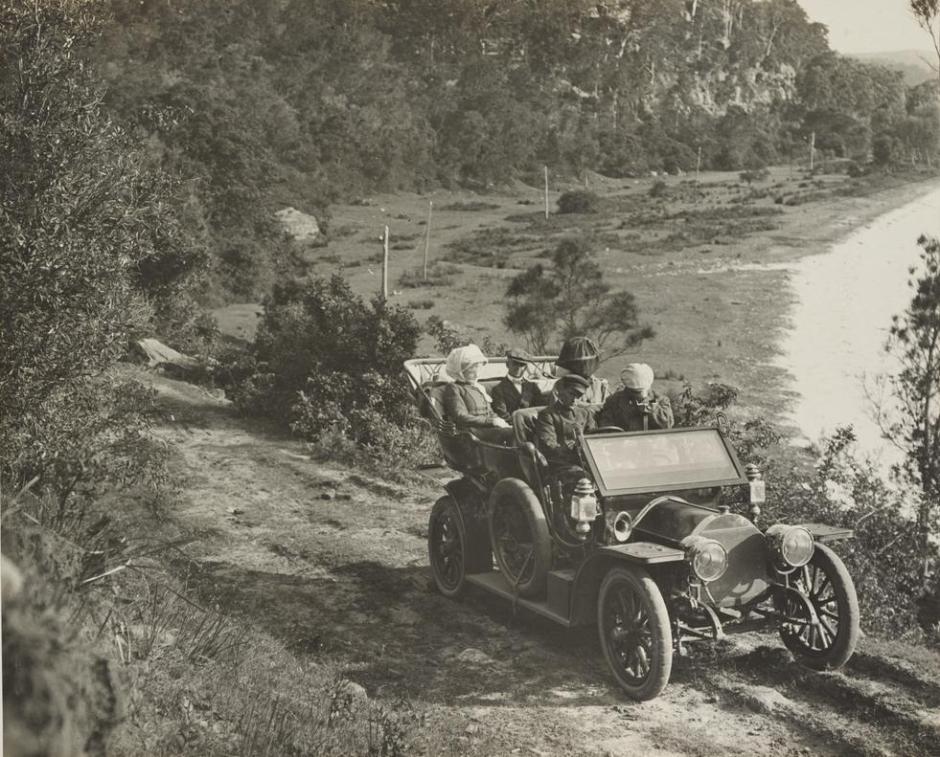The Rise of the Cruising Season: A Look at Some Early Local Visiting Beauties
With the opening of the sailing season for a community that 'sails year round', many were already dreaming of gleaming gliding keels and white sails sheer and high and taut and soft as wind above them.
Although the rise of the 'Cruising Season' initially fell after the Racing Season, there are many who now 'cruise' all year round. The rise of cruising came to be a way to see and be in places still quite wild even a hundred years after Europeans first came here, just as the sea can ever be wild when it chooses.
For those not racing south as part of this year's Sydney to Hobart, or north among the flotillas engaged in the Pittwater to Coffs or the Pittwater to the Gold Coast races, a more meandering pace will be taken and subdued green alcoves filled with brilliant azure waters will be sought and anchored in. The Basin, Pittwater and adjacent 'creeks' and bays have long been sort by those going 'cruising' during the Christmas-New Year's break, as these early yacht clubs of Sydney Harbour demonstrate:
CRUISING AT BROKEN BAY
From all the various amusements excursions heralded by more or less enticing announcements we may perhaps turn aside and give a short record of our yachtsmen and boat sailors who, whenever three or four days can be gained, invariably steal away along some 17 miles of open sea, and make Broken Bay a second Port Jackson. Tuesday morning the first of a fleet of 25 boats, or 20 excluding yachts, started with a fresh south-west wind, and arrived at midday under Barrenjoey, where boats generally send a wire back to Sydney announcing a late arrival. This was the Wanganella. On Wednesday evening she was joined by the Muriel, Pleiades, Iris, and Corinne. The Waitango arrived at midnight Wednesday, and before noon on Thursday the Maritana, Dreamland, Lottie, Snowdrop, Weringa (Mr. Charlton), Viking, Curlew, Cutty Sark, Asteroid, Pearl, Sibyl, Agnes, Zuluiku, Psyche, Colleen Bawn, had sailed round; while on Friday the Violet, Mistral, and Sao arrived. Besides these, which sailed lound, muuv brought skills on steamers, which ensures a camp, if winds are not suitable for sailing round. However, fortunately, the wind was fair both ways, and the sea for the most part smooth, with a fair swell.
If any boats have been omitted from this list it is because they were not seen among the more popular haunts; but as it is, it may be taken as showing; that our Sydney amateurs have learnt something practical as well as racing in smooth water, as the fastest boats we have of all the lengths 20 feet and over prove themselves quite safe outside with pleasure sails.
Crews of two up to six or seven seemed to be the usual party, while the smallest boats were the Iris, 10 feet, aand Cutty Sark 20, Corinne 21 feet, and others, as will be seen from the list. From Beroura Creek, some 20 miles or more up, down to Pittwater, and between those places, Cowan Creek, Wagonga Creek, and the now-famous rendezvous, the Basin, boats covered in could be seen.
The weather was very cool, but the wind very unsteady and shifting. Fish did not seem very plentiful. On Saturday evening most of the boats came down the river to the Basin, where there were 12 boats and three yachts at anchor; in fact, nowhere in Sydney harbour was there ever such a fleet of boats and boating men as occupied the bay that evening.
On Sunday morning, from daylight until noon, the boots began to drop down to the Heads, the Cutty Sark getting away at 6 a.m., and must have been one of the first back. About noon, when the sea breeze was well set, there wore 11 boats, not counting yachts, between North Head and Broken Bay-a long line right up the coast. The Dreamland and Wanganella happened to jibe round Barranjoey together, and were about 12 minutes apart at North Head ; and there must have been other pairs of boats on the way down pretty well matched. By 2 in the afternoon all except one or two were back, some going to Manly to dine, and others coming straight down to their moorings. CRUISING AT BROKEN BAY. (1884, December 30). The Sydney Morning Herald (NSW : 1842 - 1954), p. 8. Retrieved from http://nla.gov.au/nla.news-article28365019
Visit The Basin
CRUISING IN THE HAWKESBURY.
It has often been said that our aquatic amateur sailors were unequal to the task of venturing outside the Heads; but the number who have gone out during the holidays, to explore "fresh fields and pastures new," both north and south, completely disproves any such statement, and the only reason that those extended cruises do not occur oftener is because it is useless going outside unless one has at least three days to spare from business. The beautiful waters of the Hawkesbury had representatives from the different sailing clubs. The S.A.S.C. and the D.B. A.B.C. were in great force. Commodore Dietrich, Commodore M'Donnell, Vice-commodore Milson (Waitangi), and the Vice-commodores of the P.A.Y.C. and D.B.A.S.C., all went up in their boats, thus setting a good example to the other members and bearing silent testimony that we have a nucleus of at least one hundred well trained boat sailors. Exclusive of five yachts there were at least 20 boats counted about the bays in the Hawkesbury, all of which sailed out from the" Heads from Tuesday to Thursday morning. Camping out is now held in high favour, and becoming- even quite fashionable, and this too by persons owning boats that hitherto have been looked upon as mere racing machines. The Sydney Amateur Sailing Club was represented by the Asteroid, Dreamland, Lottie, Snowdrop, Muriel, Cutty Sark, Wanganella, Psyche, Colleen Bawn. The Double Bay A. Sailing Club by the Curlew Iris. The Lottie being also the commodore's boat of the other club. Besides these, there were- also present1 then} Viking, Mr.. Charlton's new boat, the Weringa, Pearly Sybil, Agnes, Zuleika, Corinne, Maritana ; the latter having made a very fast trip from Sydney. The weather was very favorable both going and coming. In going down there was a good muster on Thursday morning, some ten boats going out in close order. Some had gone on Wednesday afternoon and one on Tuesday morning.
The time made was very good both ways. A capital opportunity was given to Beat the river, as there was a fine S.E. wind and flood tide, and the majority made their way as far as Beroura Creek which was honoured by the Dreamland,. Lottie, Wanganella, Curlew, Zuleika on Christmas Day; while just below were the Waitangi and Muriel, with the Pleiades and Viking in Cowan Creek. Some boats, anchored in Wogonga Creek, the Asteroid was lying very lonely under Long Island; and some three or four others went over to Pittwater and the Basin. On Friday most of the boats worked lower down the river, and in the sea reach the Violet, Mistral and Sao, were met coming from Sydney; followed by the Wolverene, which, if report be true, found amusement and instruction in shelling the banks of Cowan Creek, and thereby setting fire to the bush and so disfiguring nature. Certainly from the basin reports were heard, and soon after bush-fire smoke was seen moving in clouds.
On Saturday evening there was a large muster at the Basin, 12 boats and three yachts laying there waiting for the return trip on Sunday. Punctually at & p.m. the Waitangi, the flagboat, of the fleet, fired her cannon; which is repeated at 8 a.m., when the flag is hoisted.
At night the scene on shore was very lively, as most of the-crews had mutual friends, and told various yarns of their aquatic experiences, and it was pretty late before the various crews turned in except for those who were going out with the early westerly at daylight.
The Cutty Sark left the basin first, followed by the Snowdrop, Pearl, and the Young Harry, a fishing boat from Double Bay, hired by some amateurs. These three got well off the land by 10a.m.; but found the E.N.E, very late in coming in. Soon after the Dreamland and Wanganella, with the Sibyl, from the river, put out, getting an offing about 11 a.m. The Dreamland came back very fast, catching the Pearl, which had a long start of some two or three miles, and beating the Wanganella by some 12 minutes. When Long Reef was reached, the scene would have made a very pretty picture. There were six boats in a heap astern or the Wanganella, and four ahead, with some yachts bowling along at a fast pace. The trip took from two and a half to three hours, and more for slower boats, from Barrenjoey to South reef, and the wind was not too much aft to stop the jib from drawing. The Curlew, Iris, Colleen Bawn, stayed behind, and perhaps others, but all the rest, so far as we can learn, reached home safely without accident.
The fair wind did not necessitate anyone having to overland it from Pitt Water to be in time-for business. Besides the sailing boats, there were numerous skiffs taken round by steamer, and the two steam yachts Eva and Northumbrian steamed up. What other ports were visited by the club's and other boats will, doubtless, be duly recorded; but for Broken Bay it may be said that it had the lion's share, and it is gratifying, to know that when such an occasion as this just past offers itself our amateurs are only too glad to vary the monotony of the smooth harbour for a lurch and a roll on our own sunny ocean. CRUISING IN THE HAWKESBURY. (1885, January 3). Australian Town and Country Journal (Sydney, NSW : 1870 - 1907), p. 38. Retrieved from http://nla.gov.au/nla.news-article71021899
Those who built these early yachts and those who commissioned them are worth knowing, for thereby the growth of an industry that remains a key part of any aquatic nation has become part of our psyche, particularly in an area where so much is centered around everything aquatic, whether you sail inshore on the Pittwater estuary or venture outwards to sail along her coasts.
For those who cruise, whether at length or just to get somewhere where they may rest, a few glimpses into past cruises here may bemuse an idle moment while waiting for their breakfast or supper to bite, while the Artworks, in a pre-photographer world, and later, the photos that were taken of these early yachts, also celebrate a great sport, relaxation and culture growing here from as soon as people had money and time enough to have a day off. Although these early sailers were built to be raced, they were also large enough to go 'cruising' in.
The first 'cruiser' of note in these New South Wales waters was The Wanderer:
THE WANDERER.
We are indebted to the Sporting Review, for the following information relative to the Wanderer, R. Y. S., the property of Benjamin Boyd, Esq., which, after accomplishing what in the strictest sense of the terms the circumnavigation of the globe, now lies gracefully, at anchor in the waters of Darling Harbour. It would be a great gratification both to our readers and ourselves, could we transfer to the columns of a newspaper, the fine sketch of this beautiful little vessel which, graces the pages of the review in question.
The sketch alluded to— which portrays the exquisite proportions of this beautiful specimen of naval architecture, is engraved after a drawing by Mr. Brierly, a gentleman of considerable note, as a marine painter, and who, we believe, accompanies Mr. Boyd, in that capacity, in his wanderings round the world. But we must not detain the reader from our extracts, which fail, however, to set the Wanderer before him in all her fair proportions : — Not the least interesting object to those who, during the brilliant days of the past month, were led, by business or pleasure over the sparkling Southampton water, was a rakish- looking schooner, that lay about mid-channel, riding as proudly and gracefully as a swan. Such as desired tidings of her, learned that she h id occupied the same berth for some time ; that her crew were engaged in embarking ample stores, that she was a yacht bound upon some far cruise ; her name the Wanderer, and that her owner was Benjamin Boyd, Esq., a member of the R.Y.S. On a golden morning borne upon waves that glittered and gamboled in the sunshine, I made my way to this mysterious galley, and was welcomed upon her deck by her kind and adventurous proprietor, I had enjoyed his acquaintance for several years : h 1 had been long known to me, for a liberal and en lightened patronage of the fine arts, and a love of enterprise worthy the age of chivalry ; yet it was with a feeling of admiration and reverence, unfelt until that moment, tin; I greeted him, and pressed, with the cordiality if affection, a hand which, animated by true British spirit, was about " to put a girdle round the earth." Can the records of any country afford an instance of a citizen, endowed with ample wealth, Mends, condition — everything to make life and home full of content and enjoyment — abandoning all, and, at his private cost, for the sake alone of manly adventure and expanded knowledge, embarking upon a survey of " the great globe itself?"
Eulogists of the good old times, what were the "grand tours" where anen , ye are wont to prate, to a passage such as this !
With a view to the enterprise in which he has engaged, Mr. Boyd, in the course of the last season, purchased the Wanderer, from Mr. Wentworth Beaumont. She is a schooner of about 140 tons, and a vessel in every way suited to the design for which she was selected. Her timbers are of unusual size for a yacht — her beam much more ample than ordinary with craft of her class, and there is about her build a union of power and grace that proclaims her fitted for purposes beyond those of mere pleasure. Her appointments have been made at an expense, whose only limits were the experience and skill of those by whom they were executed : her embellishments and appliances of comfort and luxury, were ordered by the taste of her owner — which is the same as if I had said they were perfect.
Let us introduce the reader to the main cabin of the Wanderer, and place him by my side a ; a table where her skipper is also seated. A flask of champagne is before us ; we have just pledge I " Success to the barky," and our conversation runs somewhat in this wise : — " Well, old fellow,- and so you are really determined to go the animal in its uttermost amplitude; if this be playing at sailors, I should like to know what may be navigation in earnest?"
" Yes, I do mean to make the voyage, if it please Providence ; and the route, as I have arranged it, will be thus : — Hence to Cadiz ; thence to Gibralter, Tangeirs, Madeira, Rio, the Falkland Islands, through the Straits of Magellan to Valparaiso, the South Sea Islands, generally, Sydney, China, if it be -practicable, Bombay, and then home. Mr. King, my master, has already been three years in the South Seas, and is an officer of great experience and skill. Doctor Hargood accompanies me in the capacity of naturalist, and Mr. Brierley, the marine painter, as draughtsman. The ship's company muster nineteen altogether, and the voyage will occupy, probably, two years of her accommodation you must judge for yourself."
The main cabin is amid-ships ; it is furnished with every article of luxury and convenience found in apartments devoted to general purposes on shore, to which are added various nautical instruments tastefully arranged ; the bulk-heads, that divide it from the forecastle, being covered with carved mahogany panelling, within which is a little armory of small arms. As you go aft, the first cabin on the left (the starboard hand of the vessel) is Doctor Har-good's. It is replete with comfort, and, of course, amply supplied with all things adapted to the nature of his scientific pursuits, I regret my want of knowledge disables me from giving a more particular description of them. The only item I can at this moment call to mind, consisted of a stalwart case of whale-rockets; the feeling the sight suggested is still vivid. I could not but ponder the antipodean impulses of the human heart, which lead one man to slay with the thunderbolt huge the leviathans, amid the eternal waves of the Southern Pacific, and another to do to death, with a thimble-full of patent shot, the turtle-doves of Battersea Fields and Primrose Hill.
We next come to Mr. Boyd's cabin; its fittings are plain admirably contrived for "peaceful' slumbering, on the ocean." and the prompt toilette of the sailor. Peradventure the mariners, whose portraits Smollett has left us, had it been submitted to their scrutiny, spitting their quids into their palms, would have spun yarns about lubbers and eau-de-Cologne ; it is no the wont portion of modern philosophy which has taught, that neither courage nor manhood are debased by clean linen, and the practice of laving the cuticle.
Apopos of the Pacific — hicus a non htcendo—-I ought to speak of the fashion in which the Wanderer is armed. She carries half a dozen-small brass guns, more for ornament than use, and abaft her mainmast, a magnificent piece of ordnance of the same material. It is of French manufacture, capable of carrying a great weight of metal, is swivel-mounted, and, for all purposes, ; offensive or defensive, forms the most complete battery available for a vessel of small tonnage. On deck, as below, everything is of the best, as well as the costliest : the master, Mr. King, in reply to a question of mine, respecting the binnacle (a very chaste and elegant thing certainly), told me that the expense of it was little under £200. THE WANDERER. (1842, August 12). The New South Wales Examiner (Sydney, NSW : 1842), p. 3. Retrieved from http://nla.gov.au/nla.news-article228247665
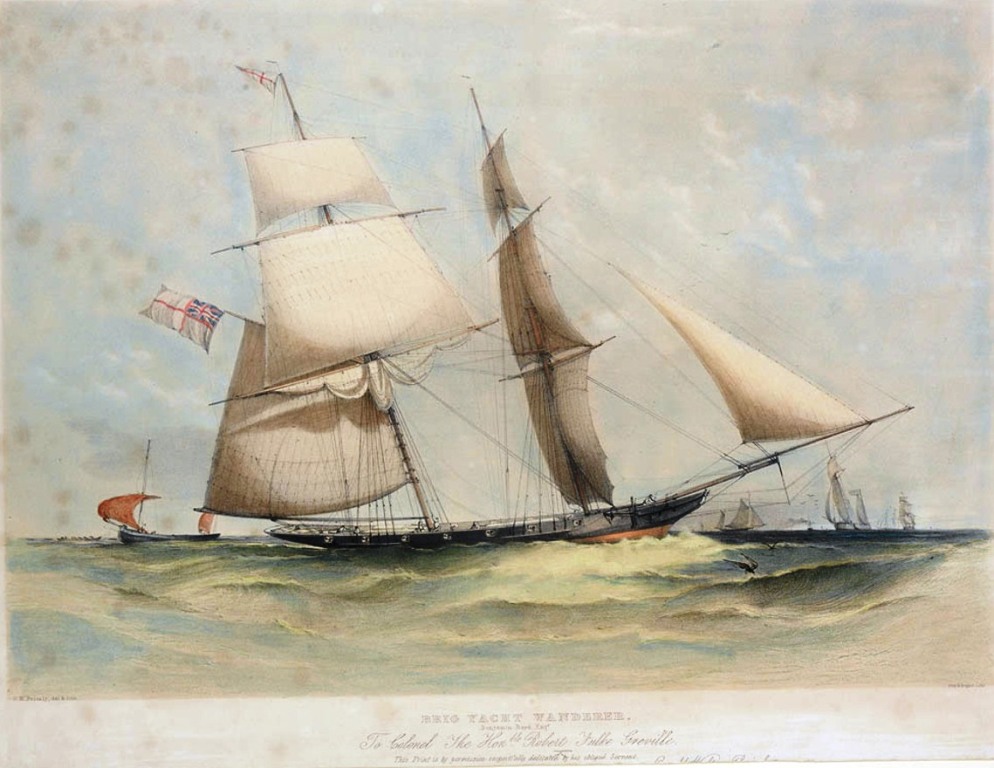
Titled at centre on mount beneath image, "Brig Yacht Wanderer. / Benjamin Boyd, Esqr. / To Colonel The Honble. Robert Fulke Greville / This print is by permission respectfully dedicated by his obliged Servant / Oswald Walters Brierly" Artist and publication details are printed beneath image, "O.W. Brierly del. & lith. Day & Haghe Lithrs to the Queen / Edmund Fry, London, & Edmund Fry Jnr. Plymouth". Image No.: a128927h 1842 / O.W. Brierly courtesy Mitchell Library, State Library of New South Wales.
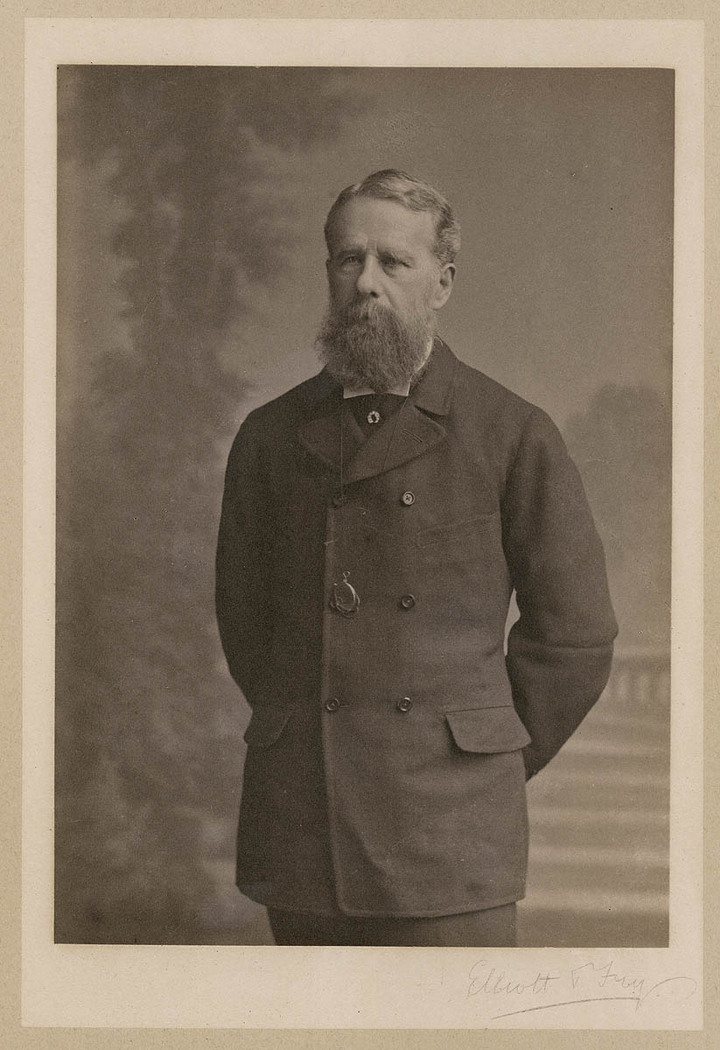
Sir Oswald Brierly, Image No.: a128915h, courtesy Mitchell Library, State Library of New South Wales.
Sir Oswald Brierly, born in England in 1817 arrived in Sydney in 1842 on the yacht Wanderer with Benjamin Boyd. He managed Boyd's whaling business at Twofold Bay until 1848 when he joined Captain Owen Stanley on HMS Rattlesnake to chart the Great Barrier Reef, the southern coast of New Guinea and the Louisiade Archipelago. He visited Australia again in 1868 during the Duke of Edinburgh's world cruise on HMS Galatea. Highly regarded in his lifetime as a marine artist and ethnographic draughtsman he was knighted by Queen Victoria in 1885. He was a member of the R.W.S. (Royal Watercolour Society). -- Curator's notes, August 2004

Sydney Cove / 1842 / O.W. Brierly. Image No.: a928514h courtesy Mitchell Library, State Library of New South Wales
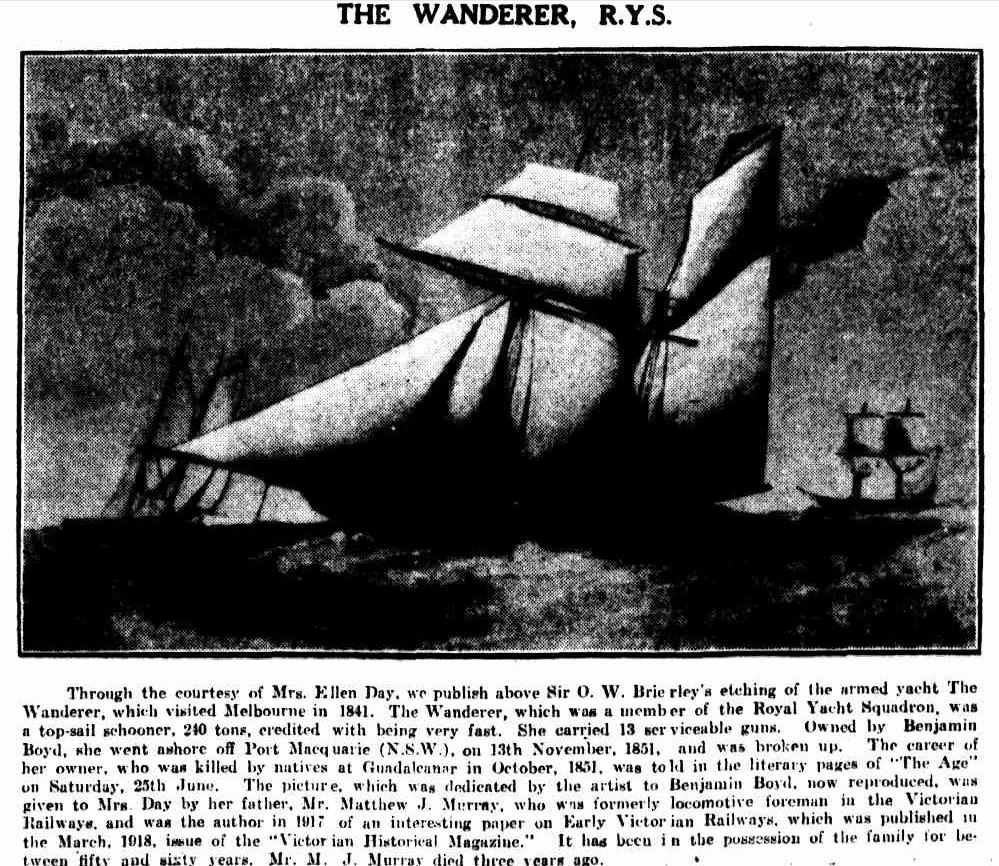
THE WANDERER, R.Y.S. (1932, July 9).The Age (Melbourne, Vic. : 1854 - 1954), p. 6. Retrieved from http://nla.gov.au/nla.news-article203800869
THE LATE MR. BOYD.
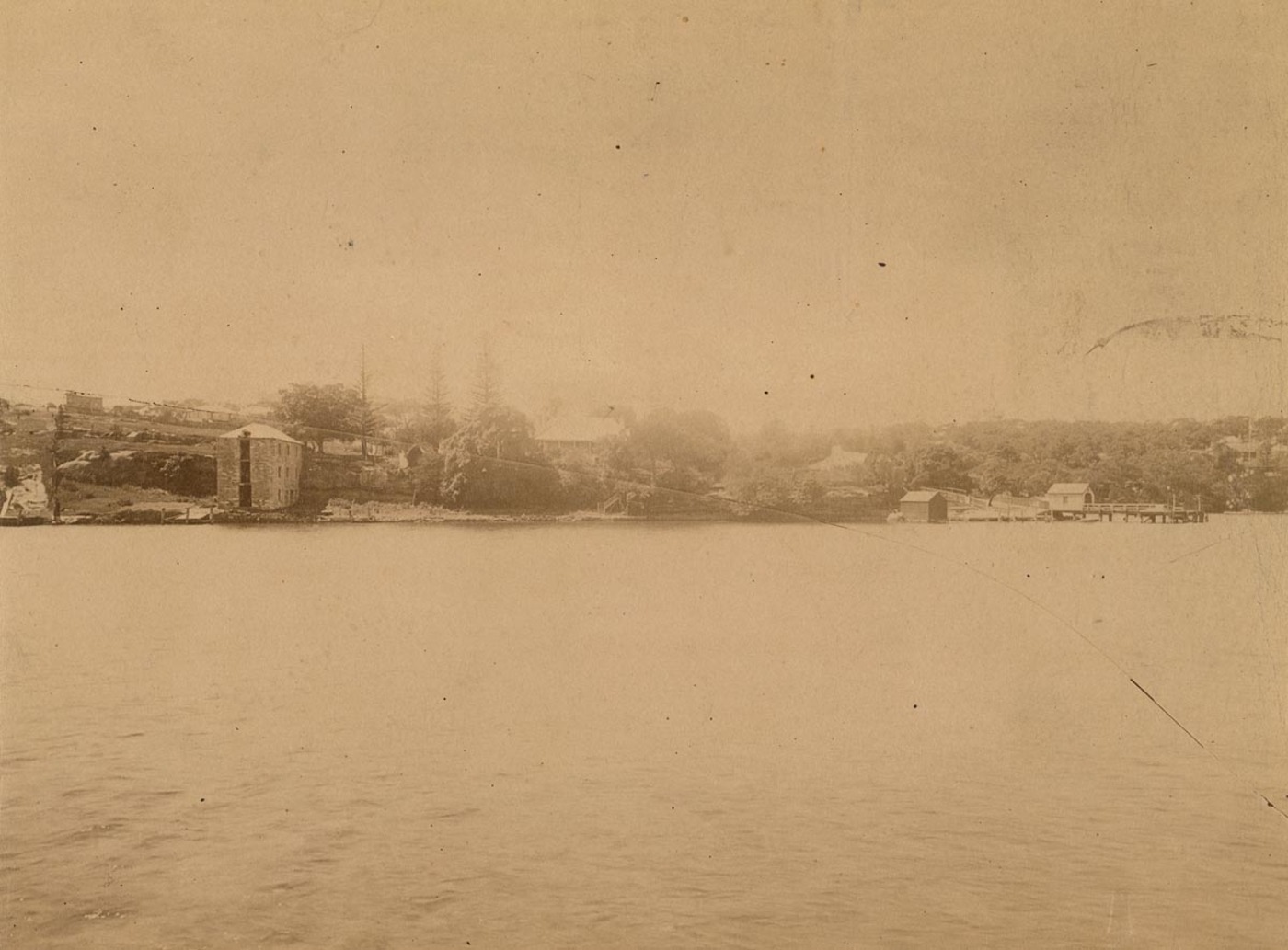
The first boat race of which we have any account was an amateur affair on May 16, 1818. It was won by Captain Piper, naval officer. The course was 3 ½ miles from Bradley's Head into Sydney Cove; and the time was 15min.
The first regatta in Port Jackson took place on April 27, 1828. But yachting was not brought specially into notice until the year 1838, when MR. JAMES MILSON, of North Shore, constructed a boat which, though originally intended for drawing wood to market, proved to be exceedingly fast and weatherly. This boat was the pioneer yacht of Australia; and the "Friendship" (for that was her name) led many a young Australian to try to turn out something like her. No one knows exactly what became of this favorite old yacht. More's the pity, because her remains ought to be canonised for the benefit of modern yachtsmen. Mr. Milson continued his career for years as a successful yacht owner and builder; but a change came with the appearance, about 1850 of THE "ECLIPSE."
This boat was built under strict secrecy by Mr. P. J. Holdsworth, at Pyrmont, to the order of Dr. Atkins son. She defeated the old style of boats easily, and for years held her own. It is not necessary to follow up the history of yachting from that time. Many alterations have been introduced, and improvements made, in the style of building. Yachting is now fairly reckoned among our national ports and in any inter colonial contest the yachtsmen of Port Jackson can hold their own. But it is not the excitement of sport as much as the pleasure of the pursuit which will always make yachting one of the many luxuries of Sydney Harbor. A PLEASANT WAY TO SPEND A HOLIDAY-YACHTING IN SYDNEY HARBOR. (See letterpress on page 17;) A Splendid Holiday Pastime. (1889, December 21). Australian Town and Country Journal (NSW : 1870 - 1907), p. 17. Retrieved from http://nla.gov.au/nla.news-article71127041
YACHTING SYDNEY HARBOUR. PAST AND PRESENT.
By FOR'D-HAND. NO. 1.
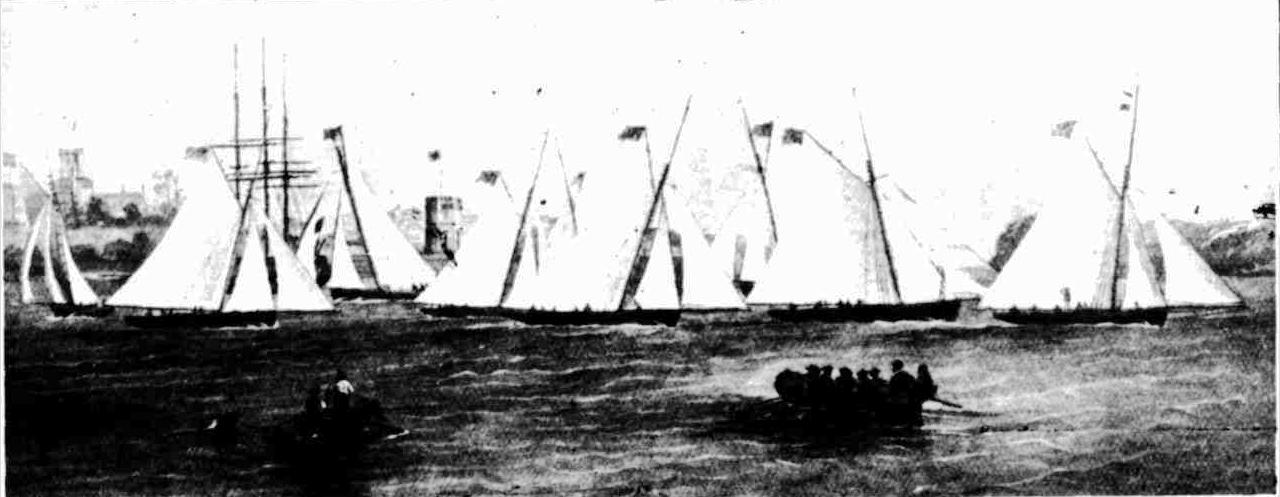
OPENING CRUISE OF THE R.S.Y.S. IN 1866.
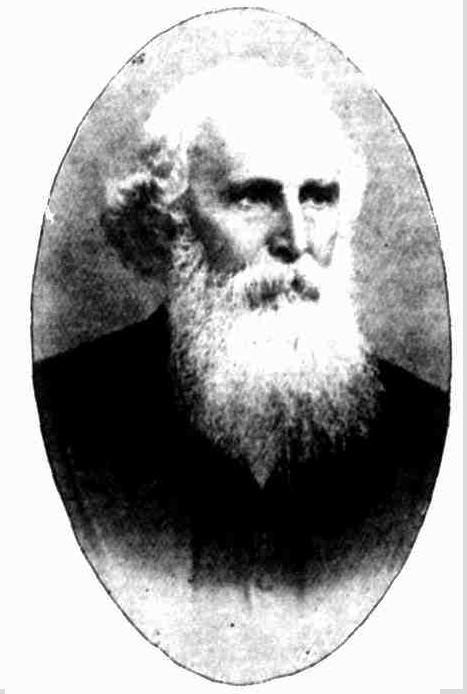
JAMES MILSON, First Vice-Commodore of the R.S.Y.S.
THE Spring is here, and with it has come the awakening of new life in the little world of white sails and gleaming hulls; the Spring is here, bringing in its train the yachting season of 1907-8. The cool breeze blowing in from the sea carries with it an unmistakable message to the man who loves a boat; be he keen racing man or plain cruiser, he understands, and, understanding, obeys the mandate. The scent of the salt sea is in his nostrils, and the call of the wave is in his ear; there is a stir in his heart, and he realises that once more there are good days to be lived. The little ships that have lain dormant through the dark days of winter have awakened from their long sleep, and know that the time has come when they may seek their natural element and spread their snowy wings to the caressing breeze; new-painted, new canvassed, bright and fresh, they come, like a flight of beautiful birds. The racing man is making him ready for the coming fray, and girding up his loins for the battles that are before him. Soon his little craft will be tuned up, like a fiddle-string, and hovering round the line, waiting for the starting-flag to fall; soon there will be once again the hard thrash to windward and the quick run home; the joy of victory and the despair of defeat. And. how well they know, those little live things of wood and canvas! How well they know what is expected of them! Within her lives a human heart, And you can hear it beat 1 When her racing-flag is flying And she's chasing up the fleet.
When her skipper, up to windward, takes the tiller in his hands,
She's just a thing of life and joy.
Ah! how she understands!
Her nerves are all a-tremble
When she hears the starting gun,
And she never thinks of resting
Till the race is sailed and done.
Ah! the dainty little racing ships,
The ships of 'winning' ways,
The ships we'll all remember
When recalling happy days!
On Saturday, 19th inst., the Sydney Amateur Sailing Club opened its season with a rendezvous under the lee of Woollahra Point. Commodore T. B. Dibbs was in command over a good muster of boats. A couple of short races were held for boats in A and B classes. In the bigger classes, Adelphi (Mr. M. A. H. Fitzhardinge) beat The Brothers (Commodore T. B. Dibbs) by a bare 20s, on time allowance, and among the smaller class Ioma (Messrs. J. T. Clinch and A. Moyse) won easily from Maysie (Dr. Sandes). The first sailing race in Port Jackson, probably, took place on the first occasion when two boats under sail, got alongside one another. The spirit of competition seems to be inherent in the nature of the healthy man, and is, no doubt, a relic of the fighting instinct of the primitive human being; all sport in which competition with a fellow-being appears is merely a modernised method of satisfying that instinct, a sort of safety valve for the pugnacious feelings which still exist, though in a rarified state, in the normal human breast.
The desire to beat the other fellow seems a natural instinct, and, after ail, sport is a mimic warfare. The earliest officially controlled racing took place in January, 1837, when the first Anniversary Day regatta was held, to celebrate the 49th birthday of the colony; but the fact that prior to that date there were pleasure sailing craft in the harbour is ample evidence that the above event was not actually the first race in Sydney Harbour between boats under sail. In fact, it is stated that as far back as 1834 the genial Captain Daniels, who often visited these waters in his clipper ship Rubicon, had ships' boats sailing against one another.
The first sailing vessel of any size, built and used for pleasure made her appearance in 1827, being the properly of Robert Campbell, of Campbell's wharf. She appears to have been an open boat of about three tons, rigged with sliding gunter mainsails and a jib. The next boat was the Eclipse, of about six tons, belonging to another of the Campbell family. A third was the Petrel, a schooner, built at Neutral Bay, for Messrs. Thomas Lord and Evans.
In 1836 the first boating club in the colony was formed, consisting of Mr. Burton Bradley (commodore), with his boat Swallow; James Milson; Sophia; John Ritchie, Ariel; Elyard, Wave; and George M'Pherson, owner of an unnamed boat. In the race of 1837 nine boats competed, and the late James Milson (then junior), won in the Sophia, the handiwork of a builder named Looke. In 1838 a S sailing skiff called the North Star, belonging to Mr. Harry Sawyer, of Balmain, appears as winner on Anniversary Day, and, in the following year, the Haidee, built for the late George Thornton, won the same event against a field of 17 starters. Some little time after this, Haidee sank off Shark Point in a 'southerly buster,' and drowned five of her crew.
Photo by Talma Studios, 374 George-street, Sydney. F. J. JACKSON.
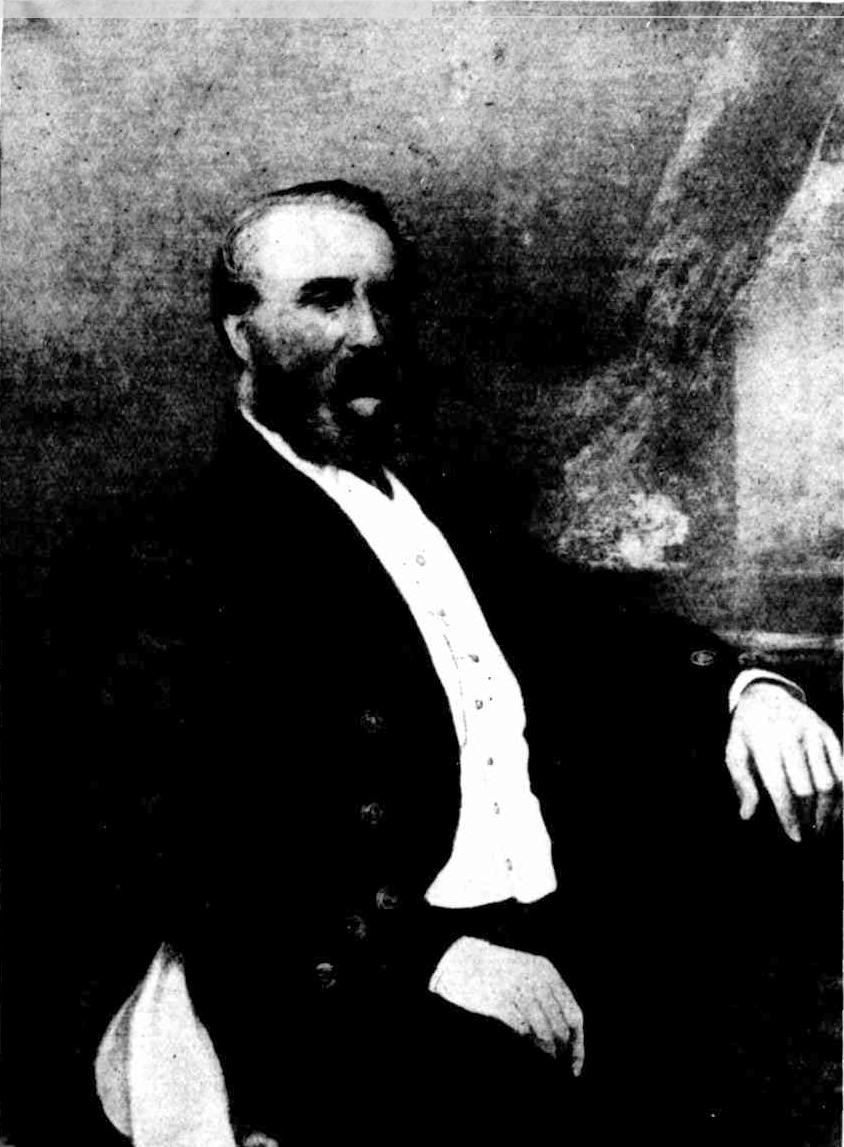
HON. W. WALKER, First Commodore of the R.S.Y.S.
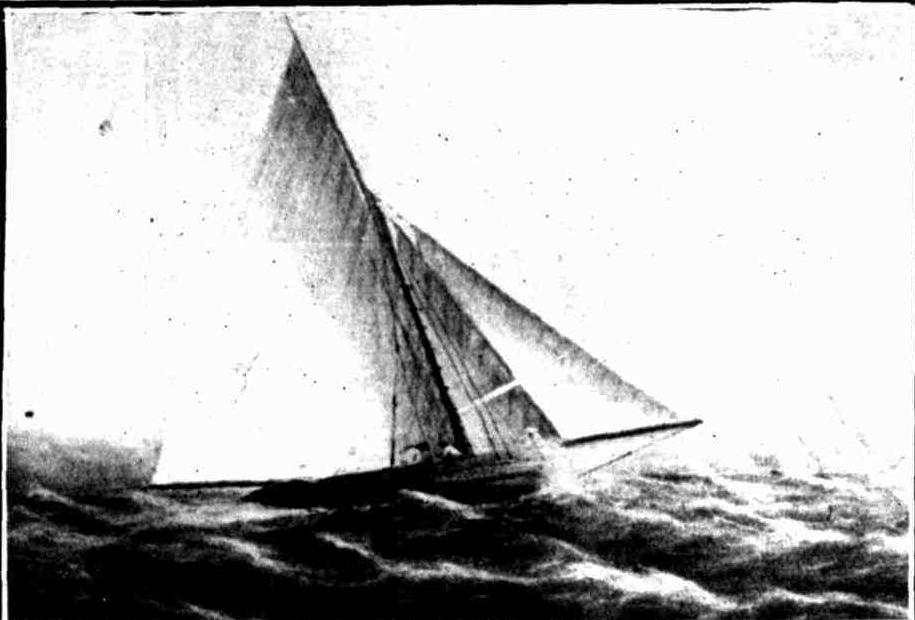
J. MILSON'S FRIENDSHIP.

J. MILSON'S ERA.
YACHTING IN SYDNEY - HARBOUR. (1907, October 30). The Sydney Mail and New South Wales Advertiser (NSW : 1871 - 1912), p. 1130. Retrieved from http://nla.gov.au/nla.news-article163659586
Yachting Past and Present : No. 1.

Photo. by Falk.
SIR JAMES R. FAIRFAX, Commodore of the R.S.Y.S.
Apparently. Mr. Milson's father had a keen eye for a good boat, and he found one in the Friendship, a decked-in craft, of about 12 tons, built by Green, up the Parramatta River, and used as a woodballast boat. He purchased her in 1841 for his son, who stepped into her out of the Sophia, and sailed her to victory in several races. She carried a sliding gunter originally, but Mr. Milson afterwards rigged her as a cutter, but not with success, as Mr. Thornton was then able to beat her in his Champion.
In the Anniversary Regatta of 1848 Mr. Randolph Want won the first-class race in the Pearl, a 40- ton schooner; Captain Stanley won the second-class event in the Asp; and Mr. Richard Harnett came in first among the third-class boats, in the Madge Wildfire. Eclipse, 10 tons, was a great boat in her day, and won at the Anniversary Regattas of 1849 in a gale of wind. She was built for Dr. Hamilton, by Holdsworth, at Woolloomooloo Bay, from an English design, and was afterwards purchased by Messrs. Alfred Fairfax and George Lord, for whom she won many races. The first-named of these two yachtsmen was one of the forefathers of sailing in this port, and his racing career extends from 1848, when he raced his first boat, the five-tonner Susan against Mr. Harnett's Madge Wildfire, till he sailed his last race in 1880 in the famous Magic. No more devoted yachtsmen ever owned a boat, and no better sportsman ever sailed a race.
The sport was keen in those days of the late forties and early fifties, and the public interest must have been encouraging to those concerned in it. We find that at the Anniversary Regatta of '55, the prize for first-class yachts was a challenge cup, valued at 250 guineas, with a purse of 100 guineas added. It was won by J. Cuthbert, in the Enchantress, a smart, boat, which won many races in her day. The first centreboard boat racing in the harbour was the Challenge, belonging to Mr. F. J. Deau, and she won her first race at the Balmain Regatta of '55; but seemed. to have a habit of capsizing on occasions; one of these was the Balmain Regatta of '56, when she turned over and lost a sure win, which fell to Enchantress. The relative merits of the deepkeeler and the centreboarder seem to have been the subject of much discussion at this time, and 'A yachtsman' expressed his feelings very strongly against the latter in a letter to the 'Sydney Morning Herald' in 1856. (Continued on Page 1123.)
YACHTING PAST AND PRESENT.
BY FOR'D-HAND.
(Continued from Page 1131.)
A small club called the Sydney Yacht Club was formed In 1856, but It seems to bare been short-lived; its commodore was Mr. Hutchison Brown, a police magistrate. Captain Rowntree's Annie Ogle makes her first Appearance in 1858, and at the Balmain Regatta — apparently her first race — she beat the Eclipse and the Mischief, hereafter referred to, in a southerly gale over the Manly course. If the report is reliable, it must have been a sight worth seeing.
'Away went the yachts before a piping southerly gale, which fairly bent their masts until the cross trees nearly touched the water. It was a glorious sight to see 'these boats in such a breeze, with seas breaking over their bows, and sweeping their decks from stem to stern, bandied with all tho ease and 6kill which could not be expected but from those who made yachting their study.'
At the Anniversary Regatta of 1861 the Sydney Yacht Club put on a race for a liberal prize of £300, which the Annie Ogle won, over a course round a boat off Botany, the Australian, which is hereafter described, being second. Captain Rowntree distributed the prize among his crew and certain charities.
Mr. H. C. Dangar won the Anniversary Regatta of '62 in the Peri, which then made a first appearance, the imported English boat Why Not, also sailing her first race on this occasion.
These were prehistoric days, so far as the Royal Sydney Yacht Squadron was concerned, but they show that the genesis of the club which has just opened its forty-fifth season was the natural outcome of the healthy spirit which moved the men who loved the sport in those piping days. It ' was no hothouse plant, requiring careful rearing; the seed was good, and it was sown in fertile ground, bringing forth a vigorous tree, which has gone on growing and spreading as the years have passed away.
On July 8, 1862, nineteen enthusiasts assembled in an office at the Exchange corner, Bridge-street, at a meeting convened by Mr. William Walker, a well-known merchant of the day, and a keen lover of a boat, and before they dispersed, the Australian Yacht Club was a reality. The document which constitutes the Magna Charta of the club now hangs in its frame on the walls of the club house at Kirribilli Point; it bears the signature, in their own proper handwriting, of these nineteen devotees of the sea, their names being: — James Milson, yacht Era; William Walker, Chance; John, P. Roxburgh, James Freeman, and H. Milford, Eclipse; Thomas T. Rowntree, Annie Ogle; Sydney C. Burt, Scud; Staunton Spain, J. D. M'Lean, and J. W. Brookes, Mischief; I. J. Josephson, Ida; Robert Garrett, Daisy; Charles Parbury, Why Not; Frederick J. Jackson, Gitana; Hy. Threlkeld, Irene; R. Harnett, Australian; A. W. H. Pockley, Mazeppa; Henry C. Dangar, Peri; H. Stuart Russell, Old Tom.
They were all well-known men of those days, whose presence was felt in the business and social life of this city of ours by the sea. But three only remain; a trio who have done much for their well-beloved sport; they are Henry C. Dangar, Charles Parbury, and Frederick Jackson. Fugaces labuntur anni.
The following are brief notes of the yachts which formed the squadron's first fleet: — Chance, a schooner of 73 tons, built of iron, in England; she sailed out, flying Mr. Walker's flag. This boat spent the last few years of her life in the useful occupation of an is-land trader, and found her last resting place in Kerosene Bay, where her well-worn iron plates and frames rusted away, and she fell to pieces. Era, a cutter of 25 tons, designed by G. and J. Inman, of Lymington, and imported in a frame by Mr. Milson. She was put together by Bates, at Careening Cove, and launched in October of 1860. Ultimately she became the Royal yacht of his Majesty King Thakambau, of Fiji, for whom she was purchased by the British Government. Eclipse is referred to above. Annie Ogle, a fast little nine-tonner, built by Andrew Reynolds, for Captain Rowntree. Scud, a 12-ton cutter, of American flat-bottomed design. Mischief, a 10-ton cutter, brought from England in 1855, by Mr. Milson. She was the creation of the well-known Harvey, of Wivenhoe, and is said to have been the first English yacht in these waters. Her fine lines forward were a surprise to the local yachts-men, who were used to the good old bluff bow. She had a good English record, but the Eclipse, Challenge, Enchantress, and Annie Ogle beat her at first. Subsequently, however, she won many races, among others the Anniversary regatta of '59 and '60. Why Not, nine tons, a fine, able, little boat, built by the celebrated Dan Hatcher, of Southampton, and brought here in 1861, won many races for Mr. Parbury. So many people asked her owner why she was not longer in design, that he thought the commencement of the question would be an appropriate name; at least, so the legend runs. Peri, an 18-tonner, built in 1861 by J. Cuthbert, came in many times a winner for Mr. Dangar — many will remember her peculiar 'tumble home' sides. Daisy, 7 tons; Ida, 8 tons; Irene, Mazeppa, Old Tom, 7 tons; and Gitana, 7 tons, were small boats of local design, and built and owned, respectively, by Messrs. Robert Garrett, I. J. Josephson, Hy. Threlkeld, Cap-tain Pockley, H. Stuart Russell, and F. J. Jackson.
Australian, popularly known in her day as the 'Beaky,' was one of the most remarkable boats built in the port, or, indeed, anywhere. The work of Dan Sheehy — who was to be seen any day on the Exchange steps, up till quite recently — she was put together at his yards at Woolloomooloo, where so many good boats of the early days came into being. She was designed by Mr. Richard Harnett, who first showed signs of his original ideas in the Madge Wildfire, above referred to. In form, she was a radical departure from conventional designs, and may fairly be said to have been over twenty-five years ahead of her time; in fact, she would not have been out of place if built under the rating rule which we have worked under up till this season. Unlike the boat of the day, with deep forefoot, long straight keel, and full round sections, her fore and aft section was almost an arc, her transverse sections were straight lines, and she was symmetrical fore and aft of the place of greatest beam, which was exactly amidships.
A wonderfully fast boat, again and again she beat boats of very much larger, size and power. It has been stated that the celebrated yawl Jullanar embodied some of the original ideas which had as-sumed definite form in Mr. Harnett's design. As her rudder-post was almost in the middle of her deck, she puzzled the official mea-surers of the squadron; but it was ultimately decided that her length should be measured from the opening in the deck, where the rud-der head came through, a decision which so reduced her measurement that she came out as under five tons, the minimum tonnage of boats eligible for the squadron's register, and she was refused registration.
At a subsequent meeting held in Mr. Walker's office on the 7th August, 1862, the rules of the squadron were formulated, and the first office-bearers appointed. They were as follows: — William Walker, Commodore; James Milson, jun., vice-commodore; Henry C. Dangar, hon. treasurer; Geo. H. Howell, hon. secretary; and Messrs. Roxburgh, Par-bury, Spain, M'Lean, and Burt, and Captain Pockley, committeemen. The opening cruise took place on the 18th of October following, when a rendezvous of yachts on the register was held in Farm Cove.
Twelve boats under the command of Commodore Walker faced a strong southerly breeze and rain and, after several evolutions were carried out, the fleet proceeded to Manly Beach, where, to quote the brief but significant note in the records, 'hampers were brought into requisition.' The Chance was not under way as she had carried away her jibboom a few days previously.
The first race for boats belonging to the squadron took place at the Hunter's Hill regatta on New Year's Day of 1863, for 'a piece of plate of the value of 40 guineas.' Peri, Scud, Ida, Why Not, and Old Tom, ap-pear to have started. Gitana was entered, but did not race as Mr. Jackson broke his arm a short while before the start, one of the consequences of a collision between his little boat and the big Era, which dragged her anchor and drifted down on top of him. The Why Not took the ground shortly after the race commenced, and the Peri had no difficulty in winning. The festive side of the sport does not seem to have been neglected, and it appears that 'a picnic to members and their friends' was given in January '63.
The accounts subsequently passed by the committee of £75, for catering by Poehlman, and £52 for wines supplied by Brown and Co., afford some evi-dence that the outing was of a pleasant and convivial nature. Music was an expensive luxury in those days, £10 being paid for the band, and steamers also ran away with money, the amount against this item being £34.
An important event in the history of the squadron was the receipt from the Colonial Secretary of a letter, dated June 27, 1863, transmitting a copy of the despatch received by the Governor of the colony from the Duke of Newcastle, to the effect that his Royal Highness, the Prince of Wales, had signified his willingness to become the patron of the squadron, under the designation of the 'Royal Sydney Yacht Squadron, and that the Lords' Commissioners of the Admiralty had author-ised by warrant (which was enclosed) the use by the squadron of the Blue Ensign of her Majesty's fleet (without any distinguish-ing mark on it). The warrant bears date the 25th April, 1863, and was subsequently replaced by a fresh warrant dated the 15th May, 1864. The squadron thus acquired, and still retains, the right to exercise the same privileges as are possessed by the Royal yacht clubs of the United Kingdom. At the next meeting of the squadron, it was resolved that the club burgee should be 'blue, with a white cross and a crown in the upper corner,' and so it still remains.
The first annual meeting was held on August 6, 1863, at which the financial statement for the first year of the squadron's existence was read, showing a balance on the right side of something over £66; the membership then stood at 79. Of the nineteen original members, Messrs. Spain and Freeman had dropped out. Among the names are many which are still well known or well remem-bered; J. O. Gilchrist, Captain Towns, Robert Massie, George Thornton, J. de V. Lamb, A. F. C. Dumaresq, Jacob L. Montefiore, Sir Wm. Manning, William Bede Dalley, James Martin, Q.C., Robert P. Abbot, Hon. John Hay, Thomas Sutcliffe Mort, Ewan W. Cam-eron, J. Grafton Ross, W. F. Cape, Hermann Milford, E. Wyld, Randolph J. Want, William Laidley, Thos. Iceton, and Laidley Mort, are a few of the names which appear. Within the next two years, among other names of members elected, are those of Fred. M. Dar-ley, Hon. J. B. Darvall, Q.C., Thomas A. Dibbs, Dr. Cox, J. R. Fairfax, William Gilchrist, G. A. Cheeke, R. Deas Thomson, Fred. H. Dangar, Gother F. Mann, Alex. Oliver, Sir Daniel Cooper, Alfred Fairfax, Frederick Lassetter, Walter Hall, James Gilchrist, Thos. Lawry, and Edward Newton.
The first club match does not seem to have been set down till January 16, 1864, and this, notwithstanding that 'Vanderdecken,' a con-tributor to the 'Sydney Morning Herald,' was complaining a year previously that the yachts had no club matches, and only met at the regattas which were then held — the Anniversary Day, Hunter's Hill, Balmaln, and Woolloomooloo. The first-class yachts were provided with a prize of a piece of plate of the value of 50 guineas, and the second-class boats with a like trophy of half the amount. The race was postponed till a week later, when the entries were more encouraging.
Captain Pockley, the commodore of the match, reported that, in the race for the big boats — which went round a buoy off Long Reef — the Xarifa, Charles Parbury; Era, Vice-commodore Milson; Peri, H. C. Dangar; Chance, Commodore Walker; and Annie Ogle, Captain Rowntree, started; but only the first three named sailed the whole course. Xarifa was the first to cross the finishing-line a long way ahead of Era and Peri. She was disqualified, however, for having received assistance from a Manly steamboat in getting off, after running aground just inside South Reef, a place where many a good boat has since picked up the land. Era took the prize; but the vice-commodore subsequently handed it back to the squadron to be sailed for the following season.
The race did not come off till 1866, when the Xarifa made no misstakes and won comfortably. The report of the matches also shows that in the second-class races — over a course round Sow and Pigs, Fort Denison, and a buoy off Manly — the Why Not, F. J. Manton; Ida, I. F. Joseph-son; Gitana, F. J. Jackson; and Scud, Sydney C. Burt, got away at the same time as the larger boats. The Why Not won easily, the Ida being eight minutes, and the Gitana 12 minutes astern. In those days, and for many years after-wards, boats started from their own moorings with head sails down, and the flying start of the present day was unheard off.
Permission was obtained to use one of the guns on Fort Macquarie, and the squadron chartered the steamer City of Newcastle at a cost of £25, to follow the race.
The matter of sails came up in 1866, when some of the members wished to restrict owners to fore and aft canvas only in club matches; but Mr. R. Want's motion that yachts should be permitted to use any sails was carried by a majority of the more progressive members. In the April of 1867, Mr. Walker resigned the office of commodore, which he had held since the foundation of the club, Mr. Milson being subsequently appointed commodore and Mr. Dangar vice-commodore. The latter, however, refused to accept office as he was not then a yacht owner. The squadron's appreciation of Mr. Walker's services to the club showed itself in an order for an oil painting of him, which now hangs on the club house walls and forms one of the treasures of the squadron. From it may be learned what the official uniform of the squadron is supposed to be. The rules still say that it shall consist of 'a blue coat, skirt lined with white silk, with a white or blue waistcoat (each with squadron buttons) and trousers white or blue; blue cloth cap, with black lace band and crown, and anchor in front.' But nowadays it would mean comment, at least, if a flag officer were to consider it necessary to follow this rule. (To be continued.)
Photo, by Talma Studios, 374 George-street, Sydney.

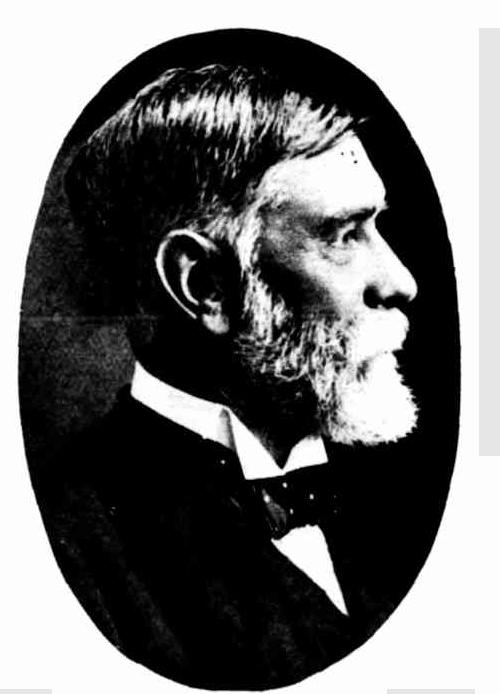
WALTER REEKS, Vice-Commodore. E. W. KNOX.

AN OPENING CRUISE OF THE R.S.Y.S. IN THE EIGHTIES.
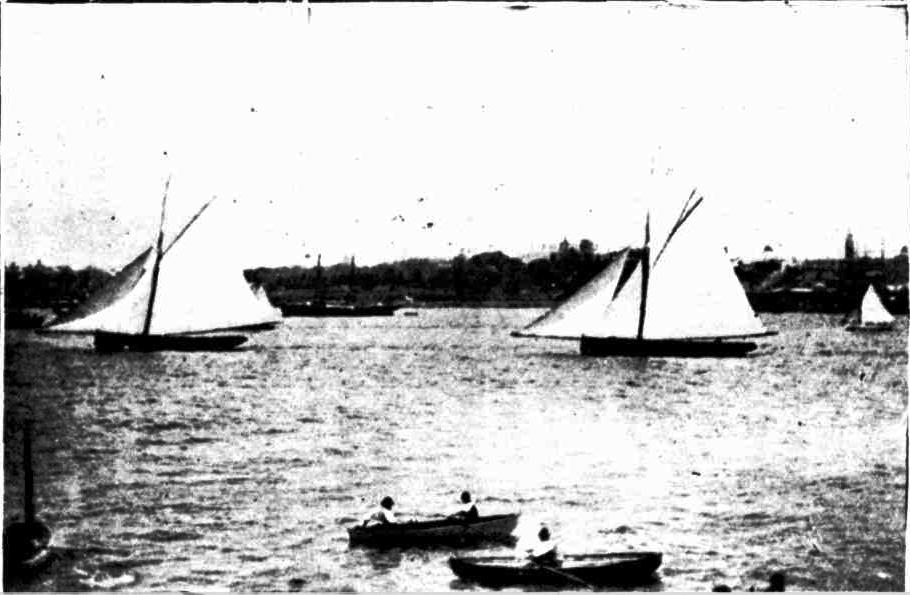
SIR JAMES R. FAIRFAX'S MAGIC AND A. G. MILSON'S WAITANGI.
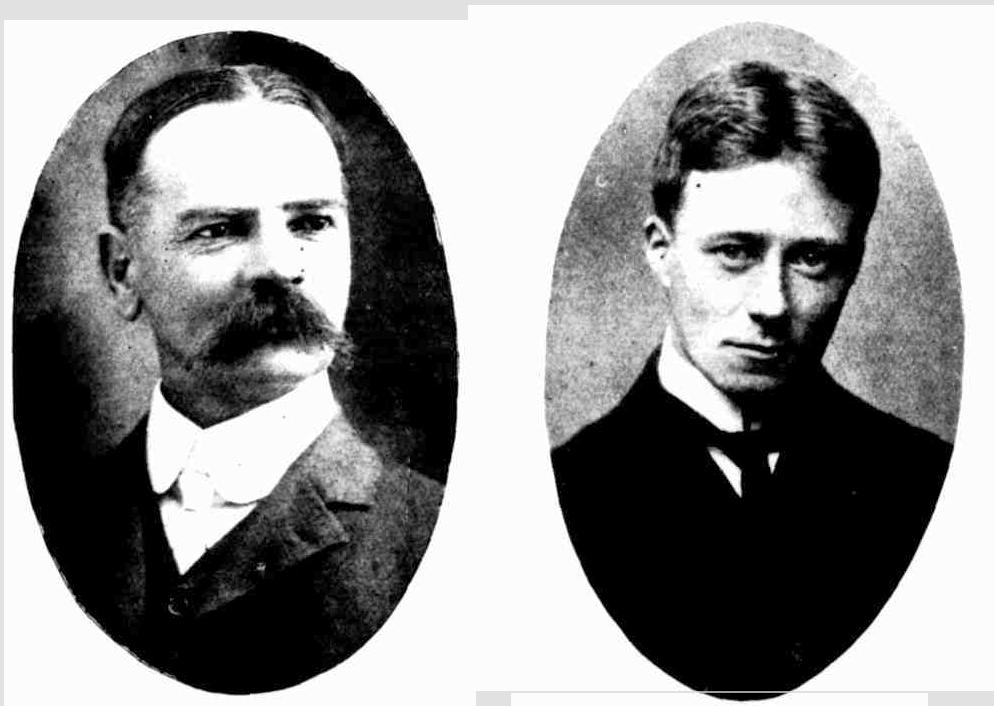
J. A. MINNETT, Hon. Treasurer. C. LLOYD JONES, Rear-Commodore of the R.S.Y.C.
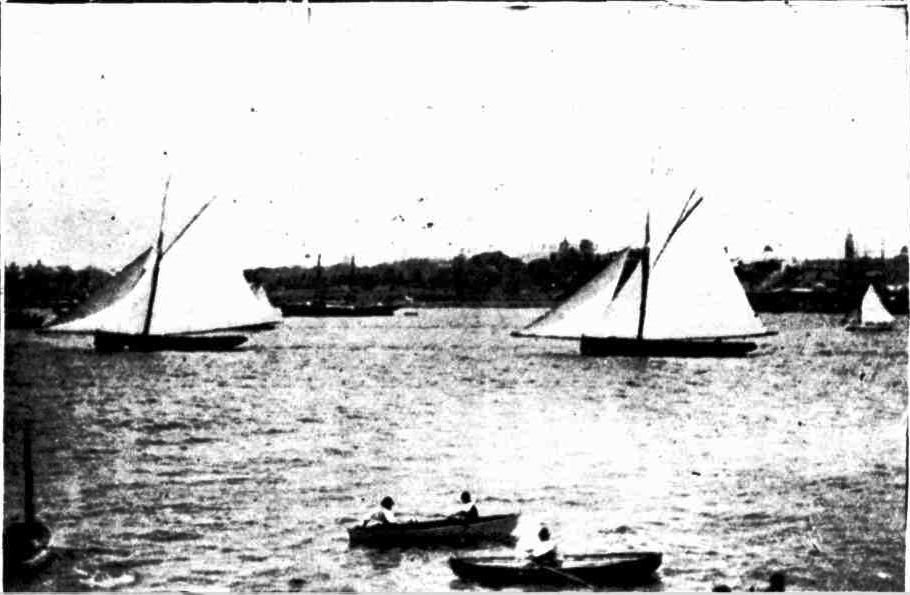
JAMES MILSON'S FRIENDSHIP AND LORD AND EVANS'S PETREL.
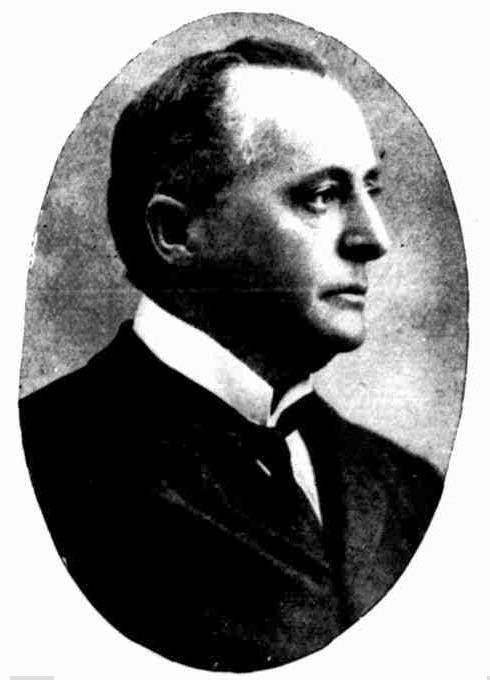
A. G. MILSON.
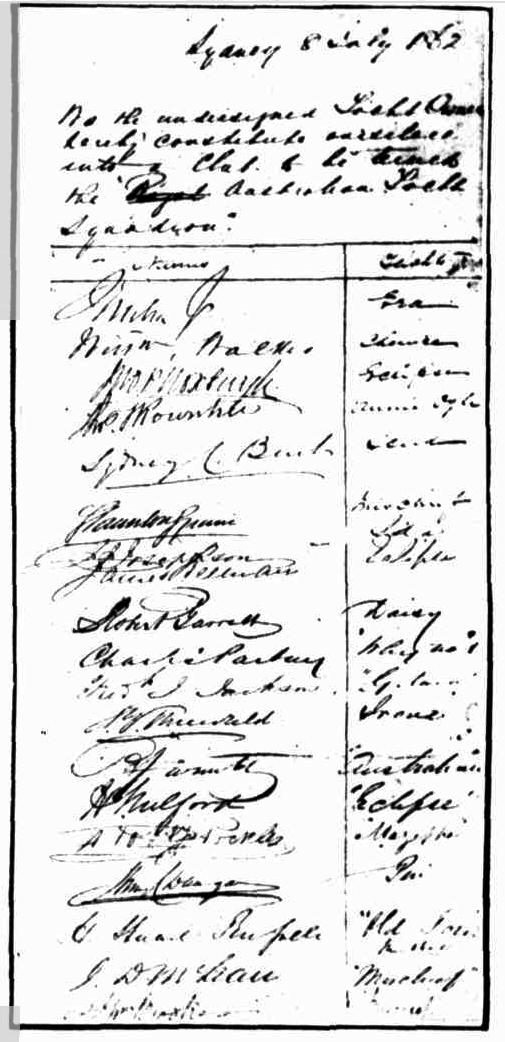
MAGNA CHARTA OF R.S.Y.S.
Yachting' Past and Present: No. 1. (1907, October 30). The Sydney Mail and New South Wales Advertiser (NSW : 1871 - 1912), p. 1131. Retrieved from http://nla.gov.au/nla.news-article163659585
One of these first Australian built yachts was constructed by amateur yachtsman, Richard Harnett, who began to experiment with yacht design in Sydney. Mr. Harnett departed from the conventions of yacht design, and built a successful racing yacht that he named, quite appropriately, Australian.
The Woolloomooloo Regatta attracted an immense concourse on the two shores of the bay, as well as in the variated crafts that dotted the harbour, propelled hither and thither by the snowy sail, or the oars with harmonious splash and phosphoric sparkle. The sports of the day comprised 16 races and dingy chase — the latter resulting in the capture of the dingy-man, both having to take to the Water. We will only notice the events where celebrities of championship- fame contended. … We should mention that the honour of carrying away the-crack prize of the day fell to the 'Australian,' D. Sheehy, beating the celebrated Ida, and the equally celebrated Mischief, which came in last. CHRISTMAS FESTIVITIES. (1860, December 29). Freeman's Journal (Sydney, NSW : 1850 - 1932), p. 2. Retrieved fromhttp://nla.gov.au/nla.news-article114839136
In 1863, Sydney yachtsmen had the opportunity to test the 'Australian type'. Wealthy businessman William Walker had imported the Chance, a large 80-ton English Schooner yacht. The Chance represented the English type. It belonged to the Royal Thames Yacht Club in England, and was the first flagship of the Royal Sydney Yacht Squadron. Xarifa, a refined version of Australian, challenged and defeated Chance in a sailing race from Sydney Harbour to Newcastle and back in 1864, finishing a good three and a half hours before the other.
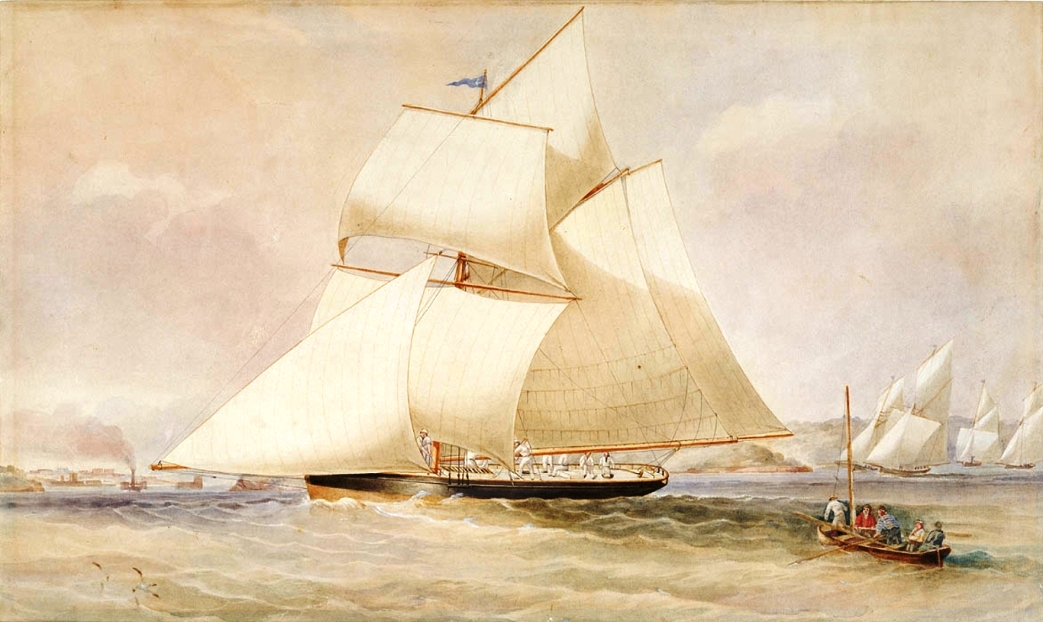
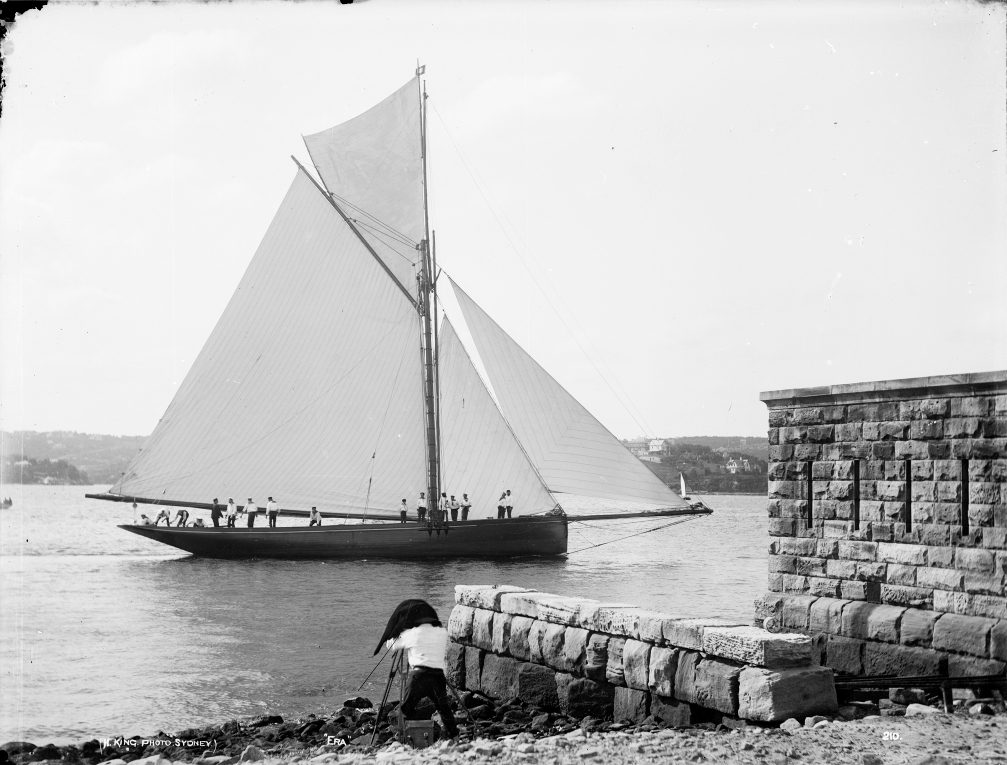
The Yacht 'Era' 1890. photo By Henry King. Courtesy of Powerhouse Museum [85/1285-165] (Tyrrell Photographic Collection).

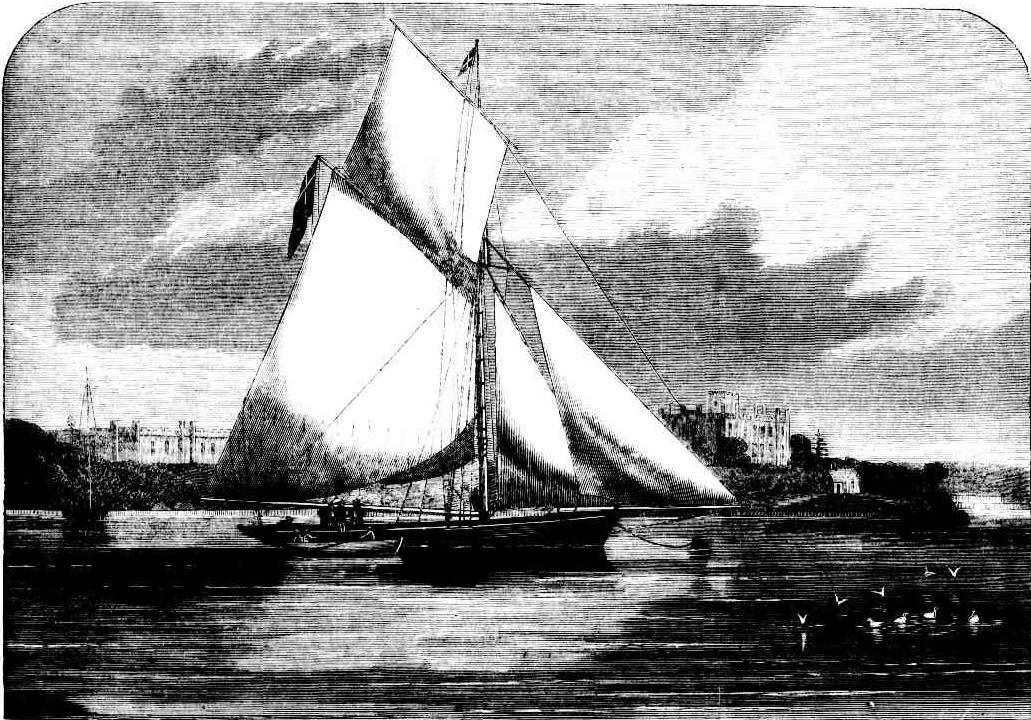
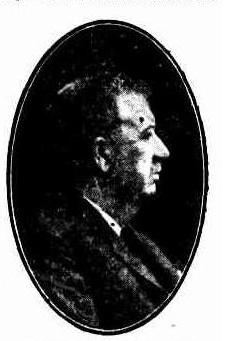 DR. J. F. ELLIOTT. DEATH IN SYDNEY. After an illness of a few months the death took place in Sydney on Sunday morning last of Dr. James Frederick Elliott, for many years chairman of directors and general manager of Elliott Brothers, Limited, Sydney and Brisbane. Dr. Elliott was a son of Dr. F. W. Elliott, one of the founders of the business, which has come to be one of the largest of its kind in the British Empire. After the death of the original Elliott Brothers the business was conducted by Mr. George C. Elliott, and the late Dr. J.F. Elliott, D.Sc, the former for many years being chairman of directors, during which time Dr. J. F. Elliott was managing director at the large chemical works and manufacturing laboratories at Balmain, Sydney. On the death of Mr. George C. Elliott, Dr. J. F. Elliott accepted the chairmanship of the company, and during the period of his control the business made very rapid strides. The doctor was one of the leading figures of the drug trade in the Commonwealth. His wide knowledge and versatility were generally recognised, and his business sagacity was availed of by many companies outside the drug trade, which he served in the capacity of director. His outside interests were many, and various. Of a naturally kind-hearted, sympathetic, and genial disposition, Dr. Elliott will long be remembered by a large body of loyal employees. Until recent years Dr. Elliott made frequent and regular trips to Brisbane, but in consequence of the amalgamation of the Brisbane branch of Elliott Brothers, Limited, with Taylor and Colledge, Limited, which took place in 1924, his visits became less frequent. He still retained his connection, however, as a director of Taylors and Elliotts, Limit-ed, and also T. and E (Surgical),Limited. His widespread business interests left him with little leisure time, and this time he usually spent in boating, fishing, and other pleasures of an aquatic nature. For many years his motor yacht, Ena, was prominent amongst the motor craft of Sydney Harbour. As chairman of Elliott Brothers, Limited, he will be succeeded by Mr. Victor G. Elliott, son of the late G. C. Elliott. Yesterday, from noon to 2 p. m., the Brisbane offices of Taylors and Elliotts were closed as a mark of respect to the memory of the late Dr. Elliott. The funeral took place yesterday. THE LATE DR. J. F. ELLIOTT. DR. J. F. ELLIOTT. (1928, September 11).The Brisbane Courier (Qld. : 1864 - 1933), p. 12. Retrieved from http://nla.gov.au/nla.news-article21355389
DR. J. F. ELLIOTT. DEATH IN SYDNEY. After an illness of a few months the death took place in Sydney on Sunday morning last of Dr. James Frederick Elliott, for many years chairman of directors and general manager of Elliott Brothers, Limited, Sydney and Brisbane. Dr. Elliott was a son of Dr. F. W. Elliott, one of the founders of the business, which has come to be one of the largest of its kind in the British Empire. After the death of the original Elliott Brothers the business was conducted by Mr. George C. Elliott, and the late Dr. J.F. Elliott, D.Sc, the former for many years being chairman of directors, during which time Dr. J. F. Elliott was managing director at the large chemical works and manufacturing laboratories at Balmain, Sydney. On the death of Mr. George C. Elliott, Dr. J. F. Elliott accepted the chairmanship of the company, and during the period of his control the business made very rapid strides. The doctor was one of the leading figures of the drug trade in the Commonwealth. His wide knowledge and versatility were generally recognised, and his business sagacity was availed of by many companies outside the drug trade, which he served in the capacity of director. His outside interests were many, and various. Of a naturally kind-hearted, sympathetic, and genial disposition, Dr. Elliott will long be remembered by a large body of loyal employees. Until recent years Dr. Elliott made frequent and regular trips to Brisbane, but in consequence of the amalgamation of the Brisbane branch of Elliott Brothers, Limited, with Taylor and Colledge, Limited, which took place in 1924, his visits became less frequent. He still retained his connection, however, as a director of Taylors and Elliotts, Limit-ed, and also T. and E (Surgical),Limited. His widespread business interests left him with little leisure time, and this time he usually spent in boating, fishing, and other pleasures of an aquatic nature. For many years his motor yacht, Ena, was prominent amongst the motor craft of Sydney Harbour. As chairman of Elliott Brothers, Limited, he will be succeeded by Mr. Victor G. Elliott, son of the late G. C. Elliott. Yesterday, from noon to 2 p. m., the Brisbane offices of Taylors and Elliotts were closed as a mark of respect to the memory of the late Dr. Elliott. The funeral took place yesterday. THE LATE DR. J. F. ELLIOTT. DR. J. F. ELLIOTT. (1928, September 11).The Brisbane Courier (Qld. : 1864 - 1933), p. 12. Retrieved from http://nla.gov.au/nla.news-article21355389
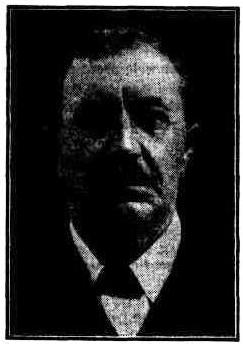 LATE DR. ELLIOTT. The funeral of Dr. James Frederick Elliott took place privately at the South Head Cemetery yesterday. One of the leading pharmaceutical chemists in Australia, he found time, in a crowded life, to engage in many commercial and other activities.
LATE DR. ELLIOTT. The funeral of Dr. James Frederick Elliott took place privately at the South Head Cemetery yesterday. One of the leading pharmaceutical chemists in Australia, he found time, in a crowded life, to engage in many commercial and other activities.
The second son of the late Dr. George Robinson Elliott, who founded the firm of Elliott Bros., Ltd., the late Dr. J. F. Elliott was born in Elliott-street, Balmain, in 1857, and was educated at the Sydney Grammar School. For his technical education he proceeded to London, thence to Germany. Returning to Sydney, he was appointed to the position of pharmaceutical chemist to Elliott Bros., Ltd., and he designed the laboratories at Rozelle. He also occupied the position of scientific director of the chemical works of the company, succeeding the late Mr. James R. Elliott as managing director of the chemical works and laboratories. In these positions he had great opportunities of showing his ability as a chemical engineer, and under his supervision great progress was made in the manufacture of sulphuric and other mineral acids, and also the manufacture of superphosphates and other chemical manures, He was a leading authority on all pharmaceutical matters and chemical engineering and was a life member of the Pharmaceutical Society of New South Wales.
During the last few years he made several visits to England, the Continent, and the Far East, and was one of the founders of the oil industry in Timor. He took a special interest in the refinement of bismuth metal.
Subsequent to the death of the late Mr.George Elliott in 1912 he became general manager and chairman of the board of directors of Elliott Bros., Ltd., and also became director of a number of other companies, including the Australian Alliance Assurance Co., Consumers' Ammonia Co., of Australia, Ltd., Taylors and Elliotts, Ltd. (Brisbane), in which were amalgamated the businesses of Elliott Bros., Ltd., and Taylor and Colledge, in Brisbane. He was a member of the New South Wales Club and the Royal Sydney Yacht Squadron. Yachting had a fascination for him and he introduced the 30ft class, and he sailed the Magic and the Meteor. Latterly, he owned the motor yacht, Lotus. LATE DR. ELLIOTT. (1928, September 11).The Sydney Morning Herald (NSW : 1842 - 1954), p. 12. Retrieved from http://nla.gov.au/nla.news-article16493486
Balmain Sailing Club; Messrs. M. A. H.Fitzhardinge, J. C. Elliott, and Dr. Elliott. R. S. YACHT SQUADRON. THE CENTENNIAIL CELEBRATION.(1887, November 3). Evening News(Sydney, NSW : 1869 - 1931), p. 8. Retrieved from http://nla.gov.au/nla.news-article108222596
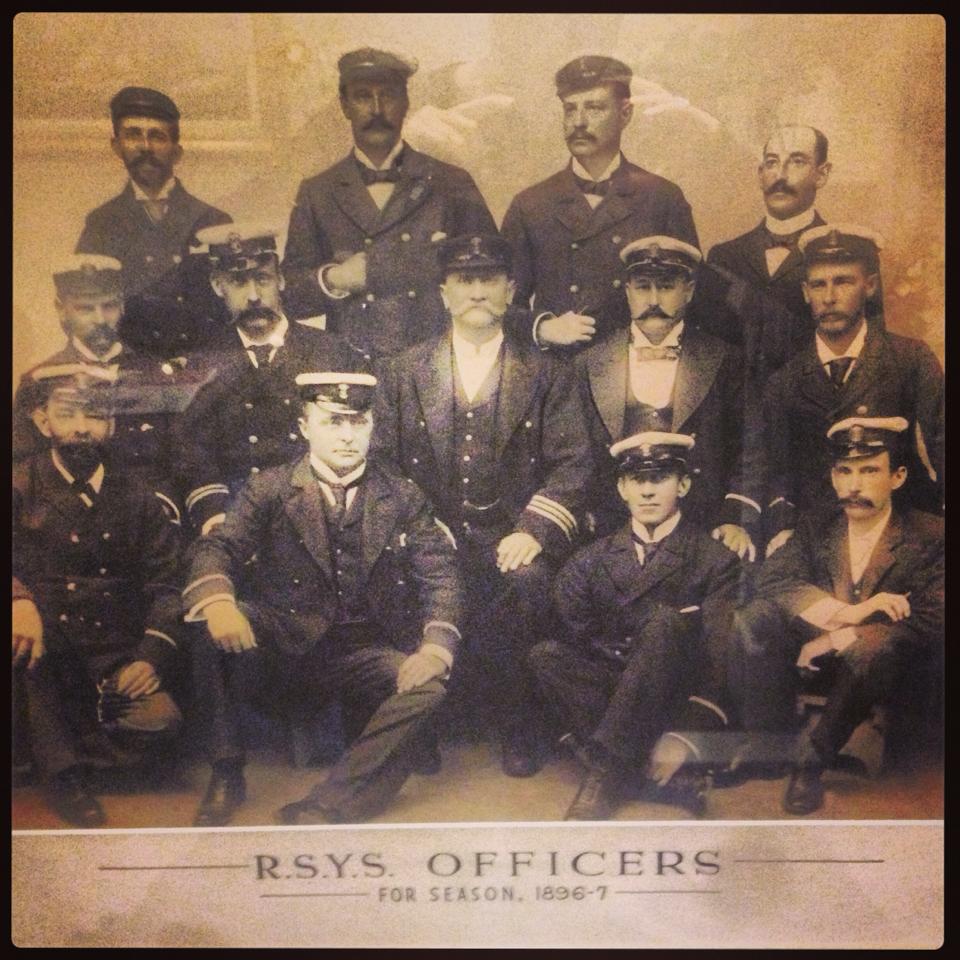
J F Elliott appears in the above image in back row, third from left (courtesy RSYS archives). The RSYS members, alike the foundation members of Pittwater's RPAYC and RMYC - Broken Bay, were captains of industry or at the top of their field. Sailing races to Pittwater, Pitt Water as a holiday destination were a clear and obvious choice. Having a Pitt Water base was part of RSYS plans and moorings and the boatshed itself, once built, were theirs up until quite recently in terms of how long Careel Bay has attracted the yachting fraternity. A map showing where Bay View Road, Careel Bay once was, is shown in the top map:
Mr. Frederick Jackson Passes
Mr. Frederick J. Jackson, who died recently at his residence, Darling Point, linked the past generation of yachtsmen with the present. In the days of the old deep keelers, Mr. Jackson was one of the most enthusiastic and successful sailing men in New South Wales, and more than held his own at the tiller against such redoubtable yachtsmen as Dr. Mackellar, Mr. Alfred Milson, Mr. Edward Knox and the late Mr. Alfred Fairfax, Dr. Milford, Mr. Jack Want and Mr. Prosper Williams. Mr. Jackson was one of the founders of the Royal Prince Alfred Yacht Club, and at the time of his death was the oldest member of the Royal Sydney Yacht Squadron. As far back as the year 1867 he won the yacht race at the Anniversary Regatta with Gitana, an eight-tonner which had been a large half-decker. With this yacht he won numerous races. Later on Mr. Jackson owned the famous yacht Mischief, in which he had years before sailed In English waters. Subsequently he purchased the Ione, and after racing her with success sold her to Mr. Alfred Milson. His last yacht was the well known and stately Violet, which was built for him in 1876 by Langford to the design of D. Hatcher, of Southhampton. Violet, in her early days, was the winner of many races- with her owner at the tiller. In his later years of yachting, however, Mr. Jackson avoided racing, contenting himself with cruising, particularly along the coast, and often sailing to Broken Bay, where he possessed a residence and property. In the '70'8, '80's and '90's Mr. Jackson was one of the inner circle of local yachtsmen, and took a leading part in the control of the sport. Of him it may be said that he was thorough—both as a yachtsman and a gentleman. PERSONALS IN SPORT . (1923, June 6).Referee (Sydney, NSW : 1886 - 1939), p. 1. Retrieved from http://nla.gov.au/nla.news-article128114326
AMUSEMENTS.
About Yachts and Yachting.
By Selvagee.
If the word 'yacht' is derived 'from the Dutch language, the practice of yachting is certainly derived from that Norse love of salt water which clings to a majority of the Queen's subjects wherever they happen to be. Whether in the old country the keenest yachtsmen are to be looked for on the English, Scotch, or Irish coast has often been the subject of much lively disputation, but in these colonies there can be little doubt that New South Wales was meant to be the nursery for colonial yachtsmen, for where will you find a depot for yachts like Port Jackson, and what Australian capital city can rival Sydney in all kinds of yachting facilities and felicities ?
For the big yacht there are Broken Bay, Newcastle, Port Stephens, within easy reach to the northward; and southward there are Botany and Jervis Bays, all good harbours for a short cruise, and some of them well worth a long exploration. For the small yacht there are innumerable boat harbours and safe anchorages all along the coast north and south of Sydney. Victoria has no such advantage, neither has Tasmania, or New Zealand, or Queensland. And yet it has always appeared to me that we make but scant use of our opportunities of enjoying the yachtsmen's true pleasure, which is Cruising.
Yacht-racing in various forms and degrees seems to occupy our yachting men’s affections to the exclusion of the infinitely more real pleasures of the cruise— just as much now as it has done for the past 30 years. Who can turn out the smartest 10 or 5 tonner is the problem at all the building yards. Who can secure the happiness of owning her is the problem of the yachting doctor and the yachting lawyer. The consequence is that our little 'ships,' however meritorious they may be as triumphs of smooth water architecture, inspire their owners with very little confidence for a week's cruise in real salt water, and as a rule the 24-foot open boat (that paradise of the harbour larrikin) ventures as far away from home as the 10 or 16 tonner. Now and then an exception comes, and a 5-tonner performs the memorable feat of sailing down the coast and through the Straits as far as Melbourne and back. I do not advocate the repetition of gush an enterprise as that, not even with 'owners onboard.' There is plenty of good cruising ground within a hundred miles, or leagues, if you like, of Port Jackson, without sending our little 'keels' on the long and dangerous errand of a Voyage to Hobson's Bay. to encounter such a long stretch of harbourless coast as Ninety Mile Beach, and run the chance of being smothered by a south-west gale when hove-to with no port to leeward and 18 inches of free board to present to a breaking sea.
I am perfectly well aware that many of the racing machines which pass in the category of yachts would be very dangerous toys on a salt water cruise, and besides being dangerous would be as wet in beating to windward against an ordinary north-easter outside as an 18-foot centreboard skiff is inside the Heads. Moreover, many yachts have no pleasure-going spars, and would commence carrying away their sticks directly they got into lumpy water; others draw too much water to allow them to get into, the boat harbours and small havens which dot the coast, and where the fishing-boat caught by bad weather finds moorings as safe as if she were in Woolloomooloo Bay, and in respect of larcenous operations much safer.
Some 14 years ago I well remember being present in Watson's Bay at a rendezvous of the Royals one Saturday, or perhaps it may have been a Friday night. There was a cruise to Broken Bar on the programme, and about nine yachts mustered and dropped anchor in the bay. During the evening a southerly wind set in, with a rather heavy sea, and a well-known fisherman (he is now in her Majesty's Service) was despatched to the Gap to report as to the state of the sea outside. He came back and reported to the Commodore that it would not be safe for 'decked' yachts to venture outside, but that open boats or fishing-boats might, if well manned, manage it.
The irony of this report was very mordant to the owners of the decked vessels, but they wisely determined to follow the fisherman's advice, and altered the trip from Broken Bay to Middle Harbour. I was then the owner of a 20-foot fishing boat, and after hearing my friend's curious comparison of the sea-going capabilities of an open boat and a decked yacht, I determined just to peep outside and have a look at it. We went outside and had a look at it, meaning by 'we' the owner of the boat and his faithful hand ''Sam,' who was in those years a pocket Hercules of about 19 years, who could work jib and mainsheets single handed in almost any weather, but whose , subsequent history was much it Silenced by Ghosts and Matrimony. Having got outside just far enough to ‘look at it,' we were overtaken off North Head by a very good specimen of the 'clear blow ' which at times makes things lively for coasters and fishermen, and elected to go, on pretty much on the principle of Mr. Hobson.
So we went on, and had a most tumultuous and moist trip to Barrenjoey, where we brought upend went ashore to wring out jerseys and have a bite at something. Being only scantily provisioned with a breaker of water, some biscuit, and a junk of corned beef, it became necessary for us to ' leather ' home next day, which we did after a terrible fatiguing beat to windward of about six hours. Arriving at our port we found that the wiser ' Royals' had had a most satisfactory time of it in Middle Harbour. Our time, on the contrary, was throughout a 'baling time.' It was a case of double-reefed mainsail and small jib, with perpetual easings up of sheets, and applications of the soup and bouilli pot, which did duty as baler.
The experience I gained by that rather eccentric trip to Broken Bay simply amounted to this, that a well-found and handled fishing-boat may inspire her foolish owner with the belief that decks are a work of supererogation. I have suffered many experiences in open-boat cruising since that rendezvous of the Royals in Watson's Bay, and the result of them is to confirm my belief in decked as against undecked vessels, notwithstanding the preference of the Commodore's referee for open boats in a gale of wind.
A year or so after that Broken Bay trip it fell to my lot to be compelled to beat up from Jervis Bay to Wollongong in one of the finest 24-footers which have ever been launched by a Sydney boatbuilder. I shall never think of Shoalhaven bight since that beat to windward without feelings of the greatest respect for the rough-and-tumble sea which a heavy northeaster brings up all the way from Abraham's bosom to the Five Islands, and especially in the southern end of the bight. We were a crew of five, and the boat was the famous old Sea Breeze, but none of us had any skins worth speaking of on our faces three days afterwards. Yes, it was a gay time no doubt, but all that crew are now some years older than then, and they take different views of things. At all events, I do. And my experiences of open-boat ocean cruising are about 25 years old.
I go for decks now, whatever I went for in bygone years, when half the pleasure of existence was made up by the dangers which could be crowded into it. In those days I, in common with many other open-boat enthusiasts, considered that the only cruiser was the open boat. I have not lost faith in it because I am now older and a less venturesome man than then. But it has become clear to me that cruising on this coast of ours can be better done in decked yachts than in open boats, or even in half decked vessels without good substantial hatches.
The owners of the racing machines may still in fine weather prosecute amateur seamanship in the recesses of Middle Harbour, or may even venture as far as the mouth of Cowan Creek after bespeaking a pleasant south-easter for the up trip, and for the down trip a pleasant north-easter. I, for one, am not going to reproach them for their want of pluck. They may be wise enough in their generations. But why is it that Broken Bay is still the Cockney retreat of Easter holiday yachtsmen, as it was 20 years ago ? Why does not some yacht startle aquatic circles by taking a trip to Jervis Bay or Port Stephens ? Take my word for it, there is plenty of good fishing and shooting (in the season of course) at both those places; and there is sure to be plenty of wholesome excitement in getting there and back: and, I verily believe, no real danger. Probably the professional who has charge of your 10-tonner will put all kinds of objections in your way, if you tell him to get her ready for a cruise along the coast further than Broken Bay, because the professional idea of a cruise is bounded on the north by Mount Elliot, on the south by Kurnel, and on the east by cannon range from the cliffs. If he has been a fisherman he may know all the harbours of refuge within open boat sail of Sydney, or if he has been skipper of a coaster he may know the coast as well as the oldest porpoise on the beat, but a lively yacht kicking about in a seaway tor three or four days at a stretch is a thing which does not captivate his imagination. Of course the only way to take such malingerers as these is to tell them that you mean to go, and that if they don't like the trip it is open to them to clear out.
I don't suppose that anything I can say of the honest pleasure, not unmixed with hard work, which cruising affords a genuine yachtsman will have much effect on the owners of those junks of lead bolted to a superstructure of wood which are now becoming so common. Let them career up and down the harbour on regatta days and 8atnrday afternoons, and let their owners continue to extract a sort of Cockneyfied enjoyment out of the operation. But any man who owns a yacht sound in hull and well found in spars and gear, although she may never have won a cup or a trophy for him, may yet win with her many a prize of far greater value than any specimen of the silversmith's art. The prize may be accompanied by a sunburnt face, and blistered hands not slightly redolent of Stockholm tar, but it is one worth taking a week's cruise for.
But before you Venture to take my advice, and cast off the moorings of your little ship for a sniff of old ocean, carefully inspect all your gear. Do not leave that to any ' hand,' however experienced, but do it religiously yourself, or if you doubt your own capacity get some Vander Decken; among your friends to overhaul your craft and her equipment. And first of all commence operations by buying and carefully studying the two Admiralty charts showing the coast line, harbours, and soundings, north and south of Port Jackson, for about 100 miles. To be quite on the safe side you ought to have all the charts of the coast in your chart-case from Twofold Bay to the Tweed, for it is always within the bounds of possibility that you may want them. With the charts you should have the latest edition of ' Wellbank’s Coasters' Guide.' As you are going for your first cruise to Port Stephens, you will make yourself familiar with all the ports, boat harbours, headlands, and dangers between Port Jackson and the Broughton Islands. If possible, you should have among your crew (who should muster at least four, so as to allow of two watches) a man with good local knowledge. A steady old coaster or fisherman is the best auxiliary you can ship for that purpose. You probably know the coast as for as Barrenjuey well enough to do without any tutoring, so it will be the stretch of coast between Cape Three Points and the Broughton Islands, or perhaps the Seal Rocks, which you require to get familiar with on paper.
This done, see that your side-ridings and flashlight appliances are all clean and in good working order, and that you have a good stock of oil, wicks, and cotton-waste aboard. Never travel in a yacht without having your tamps in good order, like the wise Virgins of Scripture. The next thing which demands your attention will be the ground tackle and warp. Never go to sea without two good anchors, suitable to the size of your yacht. For a 10 tonner, one 401b. and one 801b. anchor (long shanks and wide sharp palms are the attributes of a good yacht anchor) will suffice, and about 40 fathoms of good galvanised chain in the chain locker. A 50- fathom 4-moh coir warp is indispensable to your outfit, which should have been all worked beforehand, to make it soft and tractable. A stiff new warp is an abomination; indeed, all hew rope is; hut worst of all is one of coir. Never take your rope in the coil if you can avoid it A light land lead and it possible a deep sea lead line properly marked are part of your seagoing furniture. A miscellaneous stock of odds and ends, such as tallow, twine, tar, some oakum, marline, a needle and palm, &c., will be part of your ship chandlery stores; but these you ought to be able to leave to your captain, for they ought always to be on board. Your compasses, barometer (an aneroid is the handiest), field glass, and telescope will, of course, engage your own personal attentions; likewise your little stock of medicines. Do not load your little ship with stimulants, as if you were starting business in the public line, but take just sufficient for a crew of moderate abstainers. You will relish a glass of 'Foster' at your midday tiffin just as much off Bird Island as at Compagnoni's, and a thimbleful of good old whisky is not a wickedness during the middle watch, though repeated doses of it will be ‘distilled damnation' then as at other times. Do not move without a stock of 40 or 60 gallons of fresh water in breakers or tanks, a cooking stove such as you can rely on, or at all events something equal to the business of boiling water in hard weather, and see that you have a sufficient stock of good dry fuel. And remember, it yon want to be comfortable during your cruise, arrange beforehand that every thing shall be kept in its own place. Nothing is mere likely to derange your serenity, and sometimes to cause you serious trouble, than to keep the marmalade in the same locker as the marline, and to find the kerosene oil stowed away cheek by jowl with the butter.
Always have one anchor ready stocked, forelocked, and shackled on deck, if you can manage .to carry it there, ready to let go. You never will know until you experience it, what a trial to the temper it is to have to rouse out the anchor and chain and stock it in a hurry when everything ought to be ready to let go. Do not be without a small tool chest, in which there ought to be a good spanner, or screw-wrench, a saw, an axe or two, a metal file, a cold chisel, and a few other useful implements. Be sure that your pump is in good working order and sucks well. And have at least four or five handy galvanised iron buckets on board, also a few blue lights. Remember that a great deal of your happiness will depend on your gear being in good order and working as it ought to work. Therefore, if your bowsprit reefs on a rack, see that the rack- motion is all right; if it reefs on a roller, see that everything runs smoothly; look to the shackle of your bobstay. It is one of the most important things in the whole catalogue of your cares. See also to your forehatch; that is to say, take care that it can be easily made fast, in case it does not work on a slide. Many years ago I was one of a crew of six who were nearly drowned in a 15-tonner off Hastings because a sea came on board and carried away the forehatch, and a few toppers following we soon had a couple of tons more water inside than we wanted. Always find room for a couple of life-buoys, a good lump of a fender, and a pair of sweeps, which should work in good long crutches, one just before the port rigging, the other on the starboard quarter. Sweeps are a good substitute for a dinghee when you are flapping about helplessly in a dead calm, with a two-knot current carrying you towards some headland or reef . But now that canvas dingheee can be made so cheaply and stowed away so easily, I would advise the cruising yachtsman not to be without one.
You can always hire a boat at Port Stephens for fishing or shooting purposes, but, of course, if you prefer to use your own skiff, it is easily managed by sending her on beforehand is one of the large ketches which trade to the Myall River, and arranging for her to be dropped at Nelson Bay and left in charge of any of the fishermen there— William Hollis, for example. If you send on your boat, as I would advise every one to do who wants to be independent and do things his own way, have a roller fitted on the tack, so that you may be able to shoot a small seine or meshing net off her. It is an ineffable comfort to be sure of your breakfast of bream or whiting whenever you are lying at anchor in any of the splendid bays with which Port Stephens abounds. As to your fishing and shooting gear, I leave all those matter to your own judgement, merely observing that a good sharp harpoon and line and a lance like the instrument used by whalers are part of your fishing outfit. In the mutter of provisions, do not forget to fill up your harness casks with corned beef and ox- tongues, and take a side of good Merimbula bacon with yon. Potatoes and onions (mirable dietu) are part of your equipment, for the country about Port Stephens is not to be depended on for vegetables. Bread (which to yachtsmen of course means ship biscuit) must be carried; tea, sugar, and flour yon can buy there. But, after all, the catering business is pretty much one for yourself. Tastes differ so much in the matter of 'provedoring a cruise' that it is impossible to lay down any rules.
You are sure, like all voyagers and travellers, to forget something or other at the last moment, but don' t let it be your suit of oilskins and pea jacket. In the matter of Fails, remember that your life and the lives of your companions and crew may depend on them and their running gear. Don't move from your moorings without a good trysail neatly furled on its gaff, with sheets ready bent, and stowed away snugly in the forepeak. A handy squaresail and a storm jib, the latter especially, are indispensable. Pay all your reefing gear a little attention before getting underway, for example, the tackles of your bobstay and bowsprit shrouds, for of course you will not think of going to sea with those lubberly rods of copper or wire shrouds, stiff and inflexible as ban of lion, which some of the racing machined affect. And see that your reef penants are rove, and your 'handy billy ' really at hand.
Now, I think if you have acted on all these hints - of course if you are an old Shellback yon won't want them— your little craft will be ready for the first fair wind; or if a southerly or southeaster cannot be bespoken for the trip, just harden your heart and take what comes. You can beat up to Broken Bay, and bring up in The Basin in four or five hours against even a 'dead muzzier;' lie there snug all night, and pop out on your course northward at daylight next morning. I have seen you aboard, and your little vessel looks as if she was fit to be trusted with an archbishop. So, good-bye for the present. Perhaps next week I may give you some extracts from the log of the P. A. Y. C. Bandicoot, a seven tonner (one of poor Bill Langford's last cruisers), which made a very pleasant passage last year to the very port which I have exhorted you to visit in your more powerful and roomy clipper.
AMUSEMENTS. (1884, September 27).The Sydney Mail and New South Wales Advertiser (NSW : 1871 - 1912), p. 618. Retrieved from http://nla.gov.au/nla.news-article163270728
Vander Decken was the first captain of the Flying Dutchman.
William Langford:
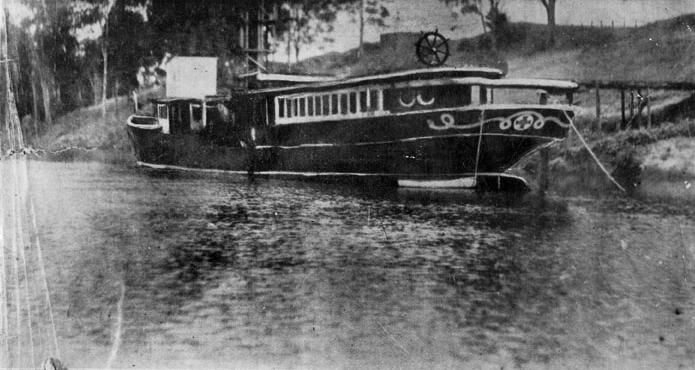
The Queensland Government yacht Lucinda. as she now lies, a "sheer hulk,'' in the Brisbane River, degraded to the position of a sand-boat. It was on this vessel, then the trim ship shown in the illustration at the right, that the Australian Constitution was framed by the Constitution Committee under the leadership of the late Sir Samuel Griffith, the last stage of the drafting being completed on board the Lucinda on the Hawkesbury River from March 27 to 29, 1891.SOME DETAILS OF THE CAPITAL. (1927, May 19). The Queenslander(Brisbane, Qld. : 1866 - 1939), , p. 34. Retrieved from http://nla.gov.au/nla.news-article25296476



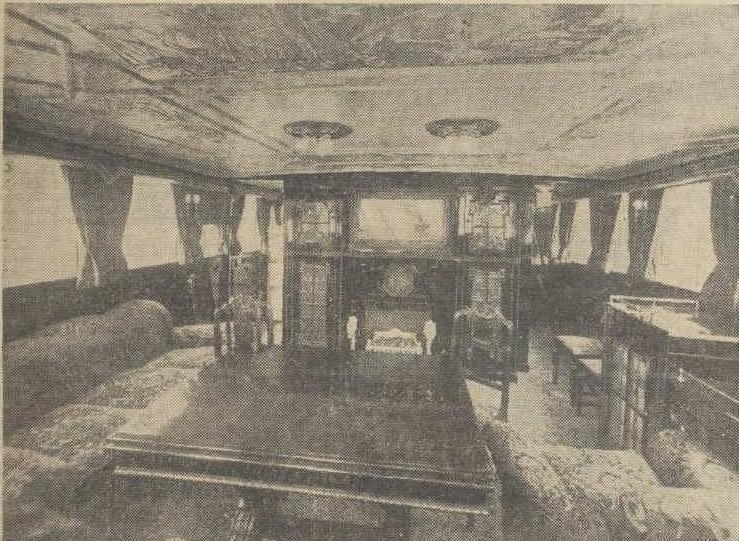
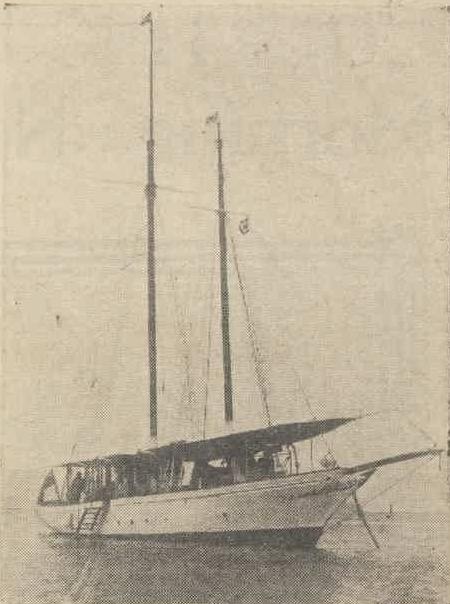

References and Extras
1. TROVE - National Library of Australia
Easter Cruises To Pittwater - From 1893 The Basin, Pittwater: A Reprise
The Yacht Australian.
Never since the first yacht race held on the waters of Port Jackson has there been a boat better known or more respected, if such a term may be applied, than the yacht Australian. The peculiar build of the vessel has made her an object of observation to all, and many who have never trod a deck speak of her with familiarity; and her performances are at all times most carefully watched.
She may fitly be chosen as an Australian representative boat, for not only bearing an appropriate title to hold such a position, she was also built here, Mr. R. Harnett, sen., being the designer and Mr. D. Sheehy the builder, who launched her some 25 years ago. The engraving will give those who have not seen the Australian ," high and dry" a very true idea of her shape, while the following measurements will doubtless be useful; Length overall, 37ft; beam, 4ft, depth from deck to keel (maximum), 7ft 6in, length on waterline, 31ft 6in.
A straight line drawn from the stemhead to the after end of the leaden keel measures 26ft, and, contrary to the present fashion, she has only a small quantity of lead (about two tons) outside, the larger amount being in the shape of ballast. This of course, according to latest discoveries, does not add to her stability in heavy weather, but nevertheless she has proved so good in all kinds of breezes that no one can doubt her weatherly qualities. One matter which is at present but indefinitely decided is her measurement, as, having no sternpost, her size cannot be arrived at in a manner fair to all, according to the orthodox style, but next season we believe it is the intention of her owner to have official advice on the subject, as lately, when remeasured by one of the clubs, it was decided to make her rank at a seven-tonner, which in every probability is a couple of tons too many. Her rigging measurements are: Length of mast, deck to hounds, 26ft ; topmast hounds to truck, 18ft, boom, 31ft 6in, gaff, 20ft 6in; bowsprit length, 10ft 6in (17ft outboard). The working sails generally used by her are :-Mainsail : foot 81ft, head 20ft, luff 19ft 6in, after leach 33ft 6in. Topsail : tack to head 3Gft, after leach 22ft, foot 23ft. Jib : luff 35ft, after leach 24ft, foot 16ft 6in. Foresail: luff 21ft 6in, after leach 18ft 6in, foot 16ift 6in. Her sail carrying capacities are too well known to need comment, and, if pressed in a race, she appears with an unequalled spread of canvas, viz., spinnaker (luff 46ft, leach 36ft, and foot 35ft), while her squaresail measures 30ft by 58ft, with raffle 10ft by 17ft, as well as an enormous ringtail. While speaking of her sails, it is only fair to mention that the fact of her using so much canvas when "off a wind" is in a great manner due to the unequalled smartness of her "for'ard hands," composed chiefly of the sons of a late respected boat-builder; and the lowering and hoisting of her various sails during regattas, and races of the past season, has been the cause of eliciting much applause from all sailing men.
It is unnecessary to give an account of all her performances during the past quarter of a century, but the following details will suffice to show her merits. Since Mr. H. Stevens has purchased her she has competed in seven public races with the following results:-Won Balmain Regatta, allowing the Dorie five minutes. Got third place in P. A. Y. Club race; Waitangi and Sirocco first and second. Secured second place at Anniversary Regatta, when she allowed the Sao two minutes; in February 16 ran third to Waitangi and Sirocco in P.A.Y. Club race. Won the third-class yacht race of the P.A.Y. Club on February 23, allowing the Sao 1 min., Doris 9min., and Ione 4min. On Saturday, March 22, she again secured first prize, allowing the Sao 3min, Ione 4min, and Doris 12min, in a P.A.Y. Club race. Woolloomooloo Bay Regatta saw her defeated by the Sao (with 2min) by 3sec, although some persons taking the time made the Australian an easy winner. This makes her winner of three races, second in two, and third in two, which cannot but be deemed a good average, considering her principal rival is fitted with every improvement, including a Lapthorne suit of sails, and was designed by the premier of naval architects.
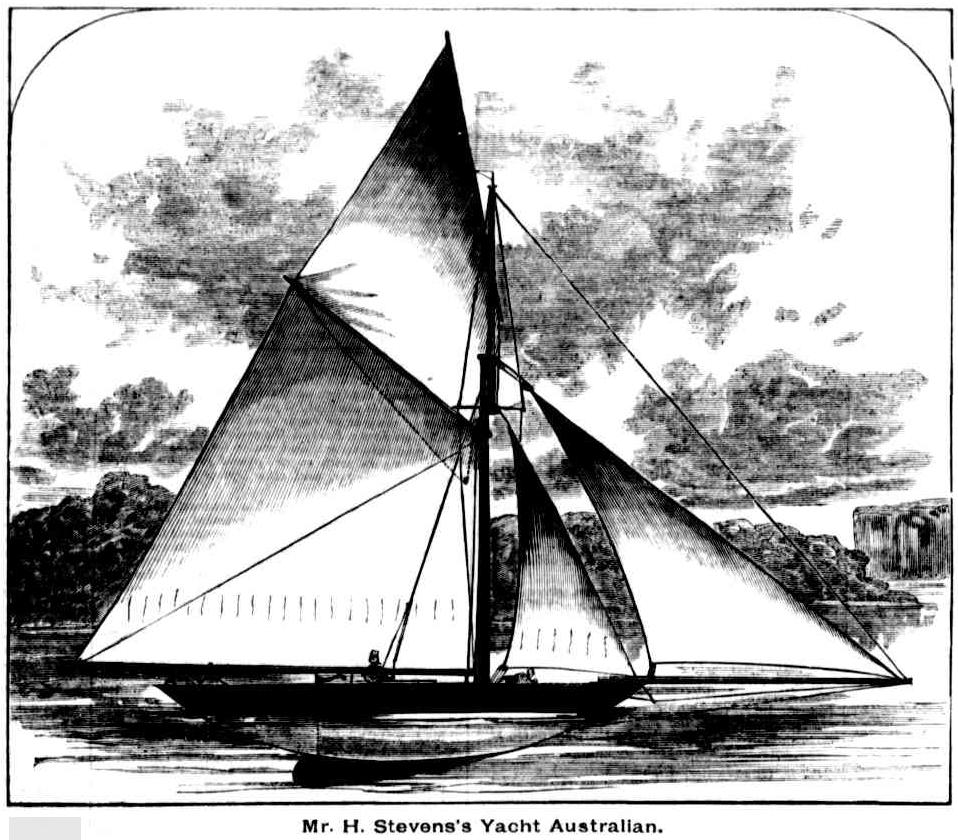
Mr. H. Stevens's Yacht Australian.
The Yacht Australian. (1884, June 14).Australian Town and Country Journal (Sydney, NSW : 1870 - 1907), p. 19. Retrieved from http://nla.gov.au/nla.news-article71013385
DEATH OF MR. RICHARD HARNETT.
Mr. Richard Hayes Harnett, a colonist of upwards of 60 years, died on Saturday afternoon at his residence, Comeen, Orchard-road, Chatswood, at the age of 82 years.
Mr. Harnett was a native of Cork, and in 1840, when a young man, arrived in this State in the sailing ship China. After a short stay in Sydney he visited Maitland, and then Wellington, where he passed some years in pastoral pursuits. Returning to Sydney, Mr. Harnett entered the old firm of Rowand and Co., general merchants, and shortly after started business in Hunter-street as a commercial broker. Deceased was perhaps best known as one of the pioneer settlers on the North Shore, and in 1871 he entered into partnership with the late Sir Alexander Stuart, with whom he was associated in opening up the whole district. He first resided at Blue's Point in
1847, but removed to Gore Hill in 1861, where he remained until 1872. In that year deceased removed to Mosman. Mr. Harnett started the first ferry ser-vice which ran to Mosman, and also controlled two lines of omnibuses running in the district, the one to the fortification at Middle Head and the other to Chatswood and Pymble, then almost bush land. When Mr Harnett first settled at Mosman there were but few residents there. Until 1884 he made the roads that Mosman possessed, and owned there a large quarry, whence some fine stone was hewn for Sydney and Melbourne buildings. He also constructed the first wharf at Neutral Bay. Deceased became second Mayor of Willoughby in 1868. He was at one time connected with the Pyrmont Brewery and the Hall of Pharmacy, King-street. Mr. Harnett assisted in the movements that secured the Milson's Point railway and the tramway services on the north side of the harbour.
As a yachtsman Mr. Harnett was well known, for he acquired a name in the early days as a skipper and designer. It was he who in 1867 designed and built the old Australian, which was launched at Woolloomooloo in that year. She was of the present type of craft, and was looked upon at the time as a remarkable boat ; but so impressed was Mr. Harnett with the merits of his design that he gave the lines of the boat to the late Mr. George Thornton in 1868, who took them to England, where they were accepted by a firm of builders. Amongst many of his yachting friends and rivals were the late Messrs. Alfred Fairfax, Isaac Josephson, and F. J. Jackson. Mr. Harnett was an original member of the Prince Alfred Yacht Club, was one of the promoters of the Anniversary Regatta, and was connected with other sailing clubs. Of the pioneers of yachting in Sydney Mr. James Milson is now the sole survivor, but up to the time of his death Mr. Harnett shared with him that honour.
The funeral took place on Sunday, the interment being made at St. Thomas' Cemetery, North Sydney, the service being conducted by the Rev. S. H. Childe. It was of a private nature. The chief mourners were :-Messrs. R. Harnett, Rolla Har-nett, Cecil Harnett (sons), J. W. Gibson and H. G. Cambridge (sons-in-law), and Lawrence (nephew) ; and amongst the few friends present were Messrs. E. J. Sievers, H. C. Catt, H. Finn, C. Ludowici, L. Finn, P. Dettman, C. Wilcox, D. Murphy, N. Dowling, and J. McLean. The funeral arrangements were carried out by Mrs. P. Kirby and Son. DEATH OF MR. RICHARD HARNETT. (1902, November 18). The Sydney Morning Herald (NSW : 1842 - 1954), p. 5. Retrieved from http://nla.gov.au/nla.news-article14505932
EARLY MOSMAN. Picturesque Period. WORK OF RICHARD HAYES HARNETT.
Mr. R. H. Harnett, of Chatswood, was with his father, the late Richard Hayes Harnett, on the day when the Duke of Edinburgh was shot at Clontarf, The incident, ho said yesterday, caused the wildest excitement, and it was only by a desperate effort that the would-be assassin was saved from being hanged to the nearest tree.
This, however, was but one event In the remarkable career of the "Showman of the Shore," as Richard Hayes Harnett was affectionately known in Sydney in the days when Mosman was mostly bush. Recalling that picturesque period, Mr. Harnett, "Junior," as he likes to be styled, notwithstanding his 88 years, said that nearly half the land in the district had once been owned by his father, who had been a man of considerable force of character, imbued with progressive ideas.
PIONEERING ENTERPRISE.
On his arrival in Sydney in the fifties (he originally came to Australia from Cork in 1840 by the ship China), Richard Hayes Harnett opened up business as a commercial broker. Inheriting, some years later, a very large fortune, he bought in 1870 some 450 acres of land at Mosman and Cremorne, and more than 1000 acres at Longueville and Chatswood.
The Mosman and Neutral Bay wharves were built by him in 1872, and he established the Mosman and Neutral Bay ferry at his own expense. The first boat was the Aberlona, and the second, Golden Rose.
About 1877, again drawing from his own pocket, he started the first line of buses from Milson's Point to Mosman, Chatswood, Longueville, Pymble, and Middle Head, thus pioneering the way for the North Shore railway. He was even able to Induce the Government of the day to make a trial survey for a harbour bridge.
In addition to giving free land for churches and parks, and building the first Public school at Mosman, he erected a beautiful mansion of 22 rooms, called Buena Vista, at the junction of Bradley's Head Road, Middle Head Road, and Military Road. Parts of the old house may still be seen behind the present Buena Vista Hotel.
A NOTABLE YACHT.
"My father," continued Mr. Harnett, "made yachting history with his remarkable boat, Australian, whose lines were adapted from a fish.
"He caught a mackerel in Woolloomooloo Bay, and, to obtain the lines that he wanted for his yacht, took the fish to his house in Victoria Street. Opening its mouth, he cut it in two parts, and proceeded to trace its lines on paper. From the design thus obtained he built the yacht, which won the race in the Regatta of 1863.
"He was appointed first commodore of the Prince Alfred Yacht Club in 1868."
A LONG ROW.
When the Harnett family first went to live on the North Shore, in 1860, there were no more than a thousand dwellings there, and all these were without water, gas, and sewerage. For water, the residents depended either upon the rainwater flow from the roofs or on creeks. Fruit drays used to come down early in the morning to a spot where the Pacific Highway is now, and often they were compelled to wait until evening to cross the water. That was the time when the Harnetts, father and son, thought nothing of rowing to Circular Quay, though there were occasions when they were given "a friendly tow." It was not to be wondered at. therefore, that when a ferry service was eventually instituted, passengers did not cavil at paying a fare of one shilling return. Even at that figure the venture was unprofitable.
Mr. Harnett mentioned that the cost of constructing roads at Mosman, between 1870 and 1882, devolved upon his father, except in the case of Military Road. Indeed, some £40.000 had come out of the estate for these and other public works, during that halcyon period, when the property was the largest in Mosman in single private ownership.
Despite his influence and wealth, however, Richard Hayes Harnett had no taste for public life. He was content to put Mosman "on the map" and to live up to his reputation as "The Showman of the Shore."
EARLY MOSMAN. (1937, September 21).The Sydney Morning Herald (NSW : 1842 - 1954), p. 10. Retrieved from http://nla.gov.au/nla.news-article17407707
[Notice of Application for a Certificate of Conformity.]
In the Supreme Court of New South Wales.
IN INSOLVENCY.
In the Insolvent Estate of Daniel Sheehy, of Woolloomooloo Bay, near Sydney.
To the Official Assignee and Creditors.
TAKE NOTICE, that Daniel Sheehy intends to apply to His Honor the Chief Commissioner of Insolvent Estates, at the Court Room, King-street, Sydney, on Tuesday, the 11th day of May next, at 11 a.m., or as soon afterwards as the course of business will admit, that a certificate be granted to him, under and according to the provisions of the Acts 5th Victoria No, 17, 7th Victoria No. 19, and 25th Victoria No. 8, Dated this 6th day of April, 1880.
THOMAS MARSHALL,
Attorney for Applicant,
133, Pitt-street, Sydney. IN INSOLVENCY. (1880, April 9). New South Wales Government Gazette (Sydney, NSW : 1832 - 1900), p. 1699. Retrieved from http://nla.gov.au/nla.news-article221626753
Death of Mr. Daniel Sheehy
A WELL-KNOWN CATHOLIC.
Mr. Daniel Sheehy, one of the most familiar figures in Sydney shipping circles died at his residence, 3 Cook-street, Glebe Point, on Thursday morning' last. He had been ailing for about two years, and the immediate cause of death was heart failure. He was a good Catholic, and was fortified by the last rites of the Church, being attended during his illness by the Rev. Father M. O' 'Kelly, of St. James', Forest Lodge, and the Rev. Father P. Piquet, S.M., of St. Patrick's.
He was 70 years of age, and a native of Kilrush, County Clare, Ireland. He came to Australia over 50 years ago, and served his time as a shipwright; at Cochran's Shipbuilding Yard, in Darling Harbour, which stood on the spot at present occupied by the gasworks. He afterwards went into business on his own account as a boat and yacht builder. He took a keen interest in yachting in those days, and designed several of the crack boats. Between 30 and 35 years ago he built a yacht called the Zarifa, which was one of the fastest crafts of her class afloat at the time. In her construction Mr. Sheehy was ahead of his day, as most of the boats now are on very similar lines. The Zarifa sailed a notable race from Sydney to Newcastle and back with an English boat called the Chance. It was a great contest, and took place whilst a southerly was blowing, but the Australian yacht won. He built a number of other well-known craft.
Subsequently Mr. Sheehy engaged in wharf-building, lightering, and salvaging, and built up a prosperous business. He was an intrepid speculator, and very seldom failed to accomplish anything he undertook. He was a keen commercial man, but withal unassuming and retiring in private life, of a charitable disposition and generous in aiding in any good purpose. In salvage operations Mr. Sheehy was regarded as an expert throughout the Commonwealth and the islands.
He was head of the firm of Sheehy and Sons, and one of the most famous feats performed by them in this direction was the floating of the four-masted barque, Falls of Garry, which was driven ashore in a hurricane on the coast of New Caledonia, in 1902, and abandoned as a total wreck. The following year he performed another smart job in Hobson's Bay, when he raised the Excelsior, which was sunk in 60ft. of water, a few miles from Williamstown, and brought her up to the docks in the Yarra. He was an enterprising purchaser of wrecks, and, in fact, was prominently identified with all marine matters, being a familiar figure at the Royal Exchange. Besides lightering and general contracting, Mr. Sheehy was connected with many big reclamation undertakings, principally at Garden Island, Woolloomooloo Bay, and in parts of the Parramatta River.
Deceased was formerly a parishioner of St. Columbkille's, Woolloomooloo, and 10 years ago he removed to Glebe Point. He was esteemed by a large number of friends in maritime circles, and the news of his death was received with general regret. He leaves a grown-up family.
The funeral which was very numerously attended, left his late residence on Saturday afternoon for Waverley Cemetery, where the remains were interred in the Catholic portion. The Rev. Father M. O 'Kelly officiated at the grave. There was a representative attendance of commercial and shipping men. The chief mourners were: Messrs. Richard and Simon Sheehy (sons), Mrs. E. Best (daughter), Mesdames R. and S. Sheehy (daughters-in-law), Mrs. Panton (niece), Messrs. C. and P. Basch, F. Stainer, and F. Best (nephews).— R.I.P. Death of Mr. Daniel Sheehy. (1906, June 28). The Catholic Press (Sydney, NSW : 1895 - 1942), p. 22. Retrieved from http://nla.gov.au/nla.news-article104909042
DEATH OF MR. DAN SHEEHY.
SHIPPING. IDENTITY GONE.
Mr. Daniel Sheehy, a Sydney shipping identity, died at his residence. Glebe Point, at 8.00a.m. yesterday. He had been ailing for some time, and gradually sank: during the last week or so. He was 70 years of age, and was connected with shipping matters for half a century.
At one time he was a big yacht owner here. He was always known as a great salvor of lost ships, and .amongst other big jobs in this line was the recovery of .the big four-masted barque- Falls of Garry, lost at Noumea, and towed to Sydney, the recovery of the Huddart-Barker liner "Excelsior, wrecked a few miles from Williamstown, and still another large contract in the wrecked steamer Riverina at Cape Everett. Many smaller but none the less Important jobs occupied his attention. His clivel's are said to have covered the bottom , of .Sydney Harbour in their peregrinations after lost anchors and other objects, and he seldom' failed in any contract he undertook In this direction. He was just as keen a judge of salvage jobs as we have seen. Outside his business of a lighterman and general, contractor he engaged in many big reclamation works, notably Garden Island and part's of the Parramatta River. His career as a yacht builder also earned some fame for him. He built the crack yacht Zarifa for Mr. Chas. Parbury, and afterwards .Mr. H. C. Dangar's Mistral, and still later Mr. R. Harriett's Australian, designing one or more of these craft. His familiar figure has been missed at the Royal Exchange during his illness, and general regret Is expressed at his death. DEATH OF MR. DAN SHEEHY. (1906, June 22). The Australian Star (Sydney, NSW : 1887 - 1909), p. 6 (FIRST EDITION). Retrieved from http://nla.gov.au/nla.news-article229662463
MR. DAN SHEEHY'S ESTATE
VALUED AT 29,326 POUNDS
Probate has been granted of the will of the late Mr. Daniel Sheehy, master ship-Wright and marine contractor, of Cook-street, Glebe Point, who died on June 21 last. The net value of the estate for probate purposes was sworn at £29,326 7s 1d. Testator appointed his sons, Richard and Simon, executors and trustees, and devised to them all personal and real estate, Including ships, machinery, stock-in-trade, &c„ employed by him In his business, upon trust, as to his personal estate, for themselves In equal shares. Out of the rents and profits of the residuary real estate the trustees were to establish annuities of £52 each for the widow and the son Michael, the balance of the Income being divided between the sons Richard and Simon for life. The will further provided, that His sons Richard and Simon should each receive £4 per week out of the Income from the real estate until the debts connected with the estate had been liquidated. MR. DAN SHEEHY'S ESTATE (1906, September 15). The Australian Star (Sydney, NSW : 1887 - 1909), p. 5 (EXTRA SPECIAL). Retrieved from http://nla.gov.au/nla.news-article228475856
SHEEHY V. SHEEHY.
A PARTNERSHIP DISPUTE.
In the Equity Court yesterday afternoon , the affairs of the one-time firm of Batty and Sheehy came under review in a dispute between members of the Sheehy family. The business is that of lightermen and general marine contractors. Mr. A. Watt (Instructed by Crick and Carroll) appeared for. the plaintiff; Mr. Street (instructed by Mr. P. J. Hourigan and Son) for the defendants.
Mrs. Mary Sheehy (widow of the late Daniel Sheehy, the younger) is the plaintiff. Her application is for the winding-up of the partnership, and the furnishing of accounts, with a view to the payment of her share. Daniel Sheehy and two sons, Richard Sheehy and Simon Sheehy, are the defendants. Mr. Thomas Garrett, Curator of Intestate Estates, represents the estate of the late Michael Sheehy.
Since the death of Thomas Batty, in 1894, the business has been carried on by Daniel Sheehy, sen., and his sons. Up to 1903 the business was carried on by Sheehy, sen., and three sons. The plaintiff claims the share and interest of her deceased husband. Mr. Street said that he was willing to submit the partnership accounts to any skilled accountant. He made this offer to Mrs. Sheehy, he said, to save expensive litigation. In reply to his Honor, Mr. Street said that the plant of the business was valued at something, over £2000. Mr. Watt, on behalf of his client, said that he would require sworn testimony as to the accounts. Mr. Street contended that what the Court, had to find out was simply what was owing to Daniel Sheehy the younger, in assets and profits, at the time of his death, not what had been made in the business since his death. His Honor: In any case there must be an Inquiry Into the partnership accounts. Mr. Street said he was opposed to such an inquiry. Argument was not concluded when the court rose at 4 o'clock. SHEEHY V. SHEEHY. (1905, November 22). The Australian Star (Sydney, NSW : 1887 - 1909), p. 7 (FIRST EDITION). Retrieved from http://nla.gov.au/nla.news-article228737278
Mr. DANIEL SHEEHY and FAMILY, and Mrs. DANIEL SHEEHY, jun., desire to return sincere THANKS for letters, telegrams, and kind expressions of sympathy in their late bereavement. Family Notices (1903, February 21). The Sydney Morning Herald (NSW : 1842 - 1954), p. 8. Retrieved from http://nla.gov.au/nla.news-article14507172
Death of Mr. Charles Parbury.
A private cable received in Sydney announced the death in London on Monday of Mr. Charles Parbury in his 81st year, as the result of an attack of pneumonia. The late Mr Parbury, who in the days when he actively followed commercial pursuits, he was one of the host known members of the old school of merchants in Sydney, was born in Sydney in 1834, his father being Mr. Frederick Parbury, who arrived in New South Wales at the end of the "Twenties", and the family were the owners of Parbury's wharf and bond. Mr Frederick Parbury, in conjunction with the late Mr. Walter Lamb, established the firm of Parbury, Lamb, and Co., one of the principal trading concerns in Sydney in the early days, and now known as Parbury, Henty, and Co. Mr Charles Parbury became a member of the firm in 1854, and had since retained his connection with the various business interests still represented in Sydney and in Brisbane. He took up his residence permanently in London in 1880, paying periodical visits to Australia in connection with business affairs. He was a director of the Union Bank of Australia, Limited, and at, one time held a seat on the directorate of the Colonial Sugar Refining Company. Ltd., besides several other financial and trading institutions. Death of Mr. Charles. Parbury. (1915, April 21). The Maitland Daily Mercury (NSW : 1894 - 1939), p. 4. Retrieved from http://nla.gov.au/nla.news-article123088828
PROMINENT MERCHANT AND YACHTSMAN
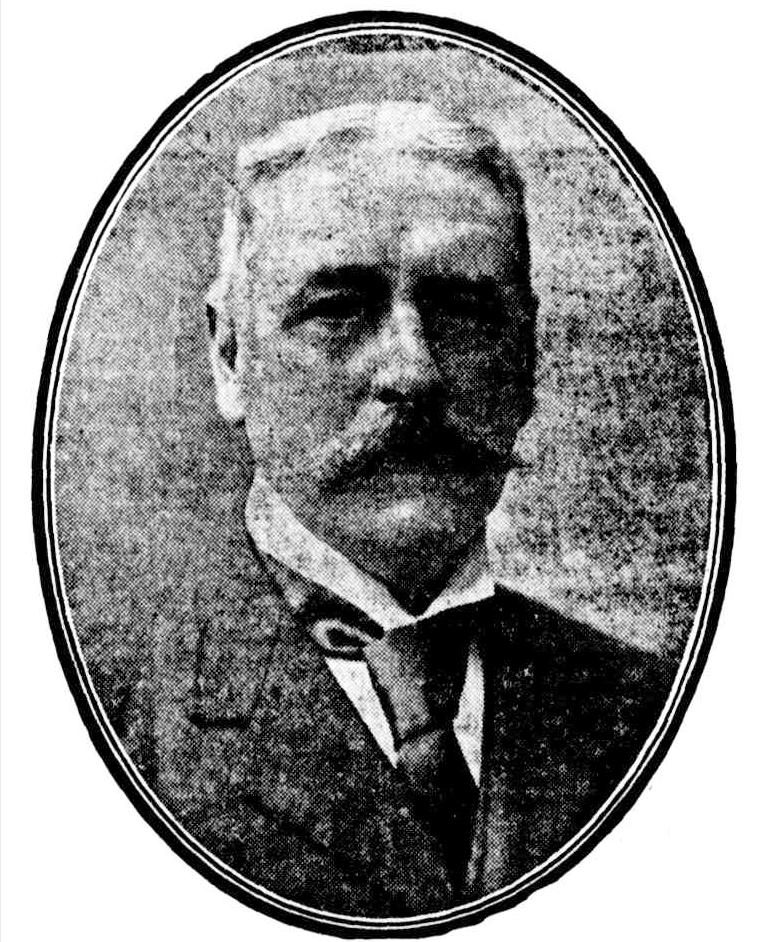
THE LATE MR. CHARLES PARBURY.
News of the death of Mr. Parbury In England was received yesterday. PROMINENT MERCHANT AND YACHTSMAN (1915, April 21). The Sydney Morning Herald (NSW : 1842 - 1954), p. 9. Retrieved from http://nla.gov.au/nla.news-article28109893
YACHTING. DEATH OF MR. CHARLES PARBURY. FAMOUS YACHT~RACE RECALLED.
A private cable received in Sydney last week announced the death in London of Mr. Charles Parbury, 'in his 81st year, as the result of an attack of pneumonia.
The late Mr. Parbury, who in the days when he actively followed commercial pursuits, was one of the best known members of the old school of merchants in Sydney (says the "Sydney Morning Herald"), was born in Sydney in 1834, his father being Mr. Frederick Pat bury, who arrived in New South Wales at the end of the '"twenties," and the family were the owners of Parbury's wharf and bond. Mr. Charles Parbury took up his residence permanently in London in 1880, paying periodical visits to Australia in connection with business affairs.
In early and middle, life Mr. Parbury was a keen yachting enthusiast, and was one of the foundation members of the Royal Sydney Yacht Squadron in 1862, being vice-commodore of it from 1867 till 1870. He was, with Sir James Fairfax, Mr. H. C. Dangar, M.L.C, and Messrs. F. J. Jackson and Alfred Milson, made an honorary life member on the occasion of the jubilee of the Royal Sydney Yacht Squadron in 1912. In the early sixties he won many races in the Why Not, built by Hatcher, of Southampton, and brought out here in 1861. In 1863 he became the owner of one of the best boats that ever sailed a race in Sydney Harbour, the Xarifa. Built by Dan Sheehy she was practically unbeatable in her day, and put up a wonderful record. She would have won her first race the first club race of the squadron if she had not got ashore just inside South Reef and availed herself of outside assistance in getting off, which led to her disqualification. The prize having been awarded to Mr. Milson in the Era, he gave it for a race in 1863, and tho Xarifa' then came into her own by winning it easily. She appeared with the fine performance of three consecutive wins in the first-class race at the anniversary regattas of 1864, 1865 and 1866. Her name, however, is best remembered as the winner of the celebrated race to Newcastle and back -a distance of about 140 miles-against the iron schooner yacht Chance, of 71 tons, owned by Mr. William Walker, one of the first commodores. That memorable event, which is, still talked of by old-timers, took place in February, 1862, and was one of the pluckiest, races ever recorded in yachting annals. Mr. Dangar was one of those aboard the Xarifa at the time. The Xarifa also' raced against the Magic, another of the famous yachts of the early days.
The late Mr. Parbury leaves a widow and five sons and four daughters. YACHTING. (1915, April 27). The Mercury (Hobart, Tas. : 1860 - 1954), p. 8. Retrieved from http://nla.gov.au/nla.news-article10411187
YACHTING PAST AND PRESENT. PRINCE ALFRED YACHT CLUB. BY FOR'D-HAND. (Continued from Page 1334.)
supplementing the brief notes on. the 'Australian already jotted down, the following extract from a letter written in 1894 to him by the late Mr. George Thornton, another devoted sailorman, may be quoted as showing that the club's first commodore was ahead of his lime, not only in Australia, but !n England:—
'When I went to England— I think it was in 1864 — you gave me drawings, etc, of the old Australian. I am not sure whether or not you also gave me a model. I saw Mr. Batsey and Mr. White, the celebrated yacht builders, at Cowes, and showed the drawings, etc, to them. They seemed to think highly of them. Mr. Ratsey said he would build a five- ton yacht from them. I left them with him. I think he did so, but I never beard with what result. I had also shown them to Hatcher, the great yacht builder of Southampton (of old-fashioned plumb stem Cutter yachts). He, pointing to the raking bow and sternpost of the Australian, ridiculed them.' It will be remembered that in January, 1868, H.R.II. the Duke of Edinburgh visited this colony, and that the arrival of the Galatea in the harbour was made the occasion of many celebrations and much rejoicing.
The squadron and the Prince Alfreds joined in welcoming the Royal visitor, and added much to the general effect when their boats formed two Bines between .which the warship passed on her way up to Farm Cove, and then followed her in line, Mr. Dangar, in the Xarife, leading the squadron's fleet, and Mr. Strickland following In the Australian, in command of len of the club's boats; all the boats anchored Bear the Galatea, and took part in the illuminations which were given at night. The sensational attempt on the Duke's life which was made by O'Farrell in the following March, at .the Sailor's Home picnic, at Clontarf, stirred all classes of the community, and we find reference o it in this minute of the club, made 'during the next ensuing month: — 'That application be made to the Admiralty for permission to fly our present ensign (white with a red cross) and that as a memorial of the visit of H.R.H. the Duke of Edinburgh, and his providential escape from the hands of an assassin, the ensign be known in future as the Prince Alfred ensign.' The application was made, but the Admiralty, in its reply (dated October 21, 1868), did not refer to the white ensign, but stated that there was 'no objection to granting permission for yachts belonging to the Prince 'Alfred Yacht Club to fly the blue ensign, with . a distinguishing mark thereon.' Later on, In a letter dated July 21, 1869, the Admiralty informed the club that 'the blue ensign with a ducal coronet' could be adopted, but asked for information as to the burgee that the members proposed to fly. After some consideration, the club wrote the Lords Commissioners that the burgee decided on was a blue ground, with a broad red cross. And this ensign and burgee are the club's flags of today.
The first race held by the club took place on March 7, 1868, in a light breeze, varying from north-east to east, and a strong flood tide. Nine boats started, being divided into three classes, as follows: — First-class. Irene. Mr. M'Taggart; Challenge, Mr. Andrews; and Australian, Messrs. Graham and Windeyer. Second-class: Galatea, Mr. Gray, and Emma, Mr. Farmer. Third-class: Royal Oak, Mr. Creed; Ixion, Mr. Brown; Dora, Vice-commodore Strickland and Ino, Mr. Langley.
Australian led all the way, and finally' drifted in at 6 o'clock, half an hour ahead of the next !boat, and won in her class. : The middle. and smallest classes were won by Emma and Ixion respectively. Challenge had bad luck, and managed to get ashore twice. Commodore Harriett was in charge of the race, on board the Scud, and after the race was over entertained the crews of the competing boats. The matter of club uniform came up for 'discussion in this year, and it was decided 'that the uniform of the club be blue coat (sac, double-breasted) and vest, white trousers, and straw yachting hat with blue ribbon,' a costume which commends itself as being neat and workmanlike, except in the matter of headgear, which must have been, an expensive item, unless prevented from getting adrift by some ingenious form of preventer backstay. The progenitor of 'the comfortable cap of the present day, no doubt; made its appearance at an early date. .The first annual report, which was read at the annual meeting, held in January, 1869, shows that the club was a healthy youngster, Inasmuch as it appears from the document that during the first 12 months of the club's existence 18 boats had been placed on the register, and the membership almost touched '. the century. , It also appears that the sinews of- war were there, the cash balance being on the credit side. The concluding words of the report are worth quoting, and may, even in these latter days, be profitably read, marked, learnt, and inwardly digested by men of this tor any other club who have the interest of the sport at heart: —
''We beg to impress upon each member of the club the necessity of taking an active interest in its progress. The mere fact of paying the annual subscription or attending one meet a year is not the mode by which the success of the Prince Alfred Yacht Club will be established. It is necessary that both members and officers should feel that much of its future prosperity depends on their individual efforts.'
Business affairs prevented Mr. Harnett from continuing as commodore, and, at the meeting,- Mr. J. W. G. Hanks was elected in his place. In the following year we find some enterprising spirits entertaining ideas of a waterside club-house, with 'a 'slip for hauling up boats. The matter went as far as the appointment of a committee, but no tangible result of their deliberations appears on the records. In this year three club races were sailed.
Commodore Hanks's Cup was won by the Australian, with Mr. Andrew's Eva second, and in the ordinary club events Mr. Strickland's Poiriona beat the Australian in the first-class races, and ' Mr. Walters's Torment annexed first prize among the second-class boats, with Mr. Bradford's Clio second. The two races were sailed in a hard southerly, which seems to have given the crews plenty of exciting work, and the annual report of the year grew enthusiastic as to the efficiency of the hands who brought their boats through. In 1872 the club laid down a definition as to the minimum size of boats eligible for admission to the club, and established the limit to 22 feet on the load-water line, and 7 feet 4 inches beam. The use of tanned sails seems to have been common, for we find a prohibition laid down against the wearing of club colours on boats carrying sails of this kind. Three classes were forged, and separate races were held for each, viz., first-class, 35 feet and over; second-class, over 25 feet and under 36; and third-class, under 25 feet. The system of double handicap — one for windward work, and the other for a lead — was. in use, and might be profitably resuscitated by th« handicappers of these days, when big and small yachts are racing together. Apparently, the ordinary method of handicapping by special officers appointed for the purpose wa3 not always considered satisfactory, for we find that it was not uncommon for each owner to send in a handicap of his own, and the commodore struck an average of the various time allowances given to each boat.
Mr. F. J. Jackson was just as enthusiastic a member of this club as he was of the Royals, and seemed to be flying his racing flag, with its blue ground and yellow bar, wherever there was a race to be sailed. We find him winning the commodore's cup in 1872 in the lone, with Osprey, E. Kirchner, second, and also in the following year taking the same event with Scud, II. Woolnough second. On the retirement of Mr. Hanks, in 1872, Mr. W. H. Deloitte, the vice-commodore, received his promotion, Mr. T. M. Brown, the owner of Alick, taking second flag. The last-named boat was a remarkably fast little ship of 9£ tons, built for Mr. Brown at the old A.S.N. works, and launched in the September of 1871. Her design was almost that of the Australian, but her keel was more conventional, and ended in a true sternpost, and her sides had no 'tumble home.' Her frames were of iron and it is not unlikely that she was one of tie first boats in which the combination of metal and wood was used. Her dimensions, appear extraordinary to the boating man of to-day; they were 52 feet over all, 42 feet from stemhead to sternpost. 8 feet beam, and 6 feet draft. She was asked to carry a great spread of canvas, as her mast was 40 feet, topmast 24 feet, boom 38 feet, gaff 28 feet, and bowsprit 14 feet. She won her first race at the Balmain regatta of 1873, when she was entered as an eleven-tonner, and easily beat Ella, Scud, Australian, Iris, and Osterley in a strong south-easter, after giving them time allowance. The report snows that much interest was taken in these matches, and the doings of the competitors before the race, like the preparations of horses for turf events to-day, were matters of great concern: — 'This was looked forward to as- the event of the day, and great disappointment was felt when It was rumoured that Alick had carried away her rigging on the previous afternoon; but Jack Carrol and his crew went to work with a will, and by daylight next morning had a new set of rigging, and she was seen getting away from her moorings at 10.30.'
The Anniversary Day race of the following year must have been an exciting contest, and the report makes good reading. Alick apparently sailed a fine race in a howling nor'nor'easterly, and after sailing over an outside course round a boat off Curl Curl and then round the Flagship and Sow and Pigs, she led over the finishing line nearly six minutes ahead of Pert, J. F. Josephson, nearly, nine minutes ahead of the smart little Nereid, A. Fairfax, and over 12 minutes in front of the Ella, A. Farmer. Although Pert was a much larger boat she received a time allowance of 6 minutes, and so the Alick lost the £50 prize by about half a minute. The result of the race seems to have caused dissatisfaction among the boating 'men, and Mr. W. E. King, a keen sailing man, in a letter to the 'Herald' a few days after the event, puts it plainly that the Alick had been badly treated by the handicappers. He stated that it was considered desirable by some to discourage boats like the Alick, on the ground that they were not yachts but racing machines, but when we learn from the totter that the boat which was then looked on by some as a freak had sleeping accommodation for. eight men, and deck room for a working crew of twelve, carried more sail and stood up to it better than any boat of her class, the thought arises that it would be interesting to see what those conservatives would think of some of the modern boats, like, for instance, the Sunbeam or the Janet.
Mr. King was more enterprising, however, and came to the conclusion that if the Alick was a racing machine the sooner they left off building yachts and took 'to machine-building the better. The Alick was afterwards lengthened, and her stern altered, but these changes spoilt her, and she was not the same certain winner afterwards. . Commodore Deloitte owned the Ianthena, a large centreboard boat, stated to be twice the dimensions of the 22-feet waterman's skiff of those days. Off the wind or on a lead she was very fast. In the Anniversary Regatta of 1874 she was called on to give Alick, the only other competitor, six minutes, and she appeared likely to do it. as she had more than hall her time in hand at the end of the start round, but off Bradley's on the second turn down she carried away her boom, leaving Alick to finish alone. (To be Continued.)
Yachting Past and Present. (1907, November 20). The Sydney Mail and New South Wales Advertiser (NSW : 1871 - 1912), p. 1311. Retrieved from http://nla.gov.au/nla.news-article163659078
SYDNEY YACHTING MEMORIES - THE FAMOUS 'AUSTRALIAN' OF GLORIOUS MEMORY
By H. C. PACKHAM.
So much reference has been made in previous articles on old-time sailing in Port Jackson to the famous little yacht Australian, that a column shall now be devoted to her and her achievements alone. The writer was introduced to and first sailed in the Australian in the early eighties, when she belonged to a resident of Pott's Point, and found her moorings in Woolloomooloo Bay, near the yards of old Dan Sheehy, by whom she was built. Her then owner did not race her often, but as he was a man of substance, he kept her more for the pride of possessing her than anything else.
A WONDERFUL RACER.
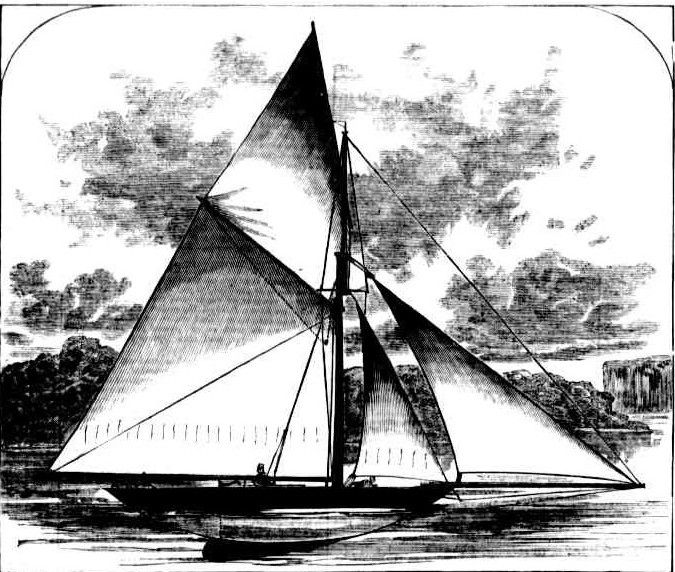 The history of this yacht dates back some 50 odd years. Designed by a genius named Harnett from the section of a mackerel, the Australian had — for, alas ! she is now a thing of the past — a record as a racing yacht that would put that of any modern vessel completely in the shade. It was owing to her peculiar design — both ends (stem and stern)being alike — that Australian was known by some half-dozen names. Appropriate and beautiful as was her real name, some called her the lemonade bottle; some referred to heras the cigar, others as the Beaky, owing to her overhanging ends; but she was called by thosewho knew her best 'The Old Boxer.'
The history of this yacht dates back some 50 odd years. Designed by a genius named Harnett from the section of a mackerel, the Australian had — for, alas ! she is now a thing of the past — a record as a racing yacht that would put that of any modern vessel completely in the shade. It was owing to her peculiar design — both ends (stem and stern)being alike — that Australian was known by some half-dozen names. Appropriate and beautiful as was her real name, some called her the lemonade bottle; some referred to heras the cigar, others as the Beaky, owing to her overhanging ends; but she was called by thosewho knew her best 'The Old Boxer.'
KEEL OF THE DUNBAR TIMBER.
Not the least thing associated with this marvel of Port Jackson was the fact that her keel had been constructed from one of the timbers of the ill-fated ship Dunbar, which was wrecked at The Gap, Sydney Heads, in August,1857.During her long and successful career Australian had numerous owners, but better known and more closely associated with her later years was her skipper, the late Mr. Henry Stevens. No one, perhaps, understood The Old Boxer better than 'Harry Stevens, who time and again sailed her home to victory. Actually on correct measurement she was not more than 4 ½ tons. Her stern-post, had she had one, would have been perpendicular; but her rudder-head came up through a tube from her keel well amidships. In consequence of this, and having no stern-post, she was measured from end to end and rated at 7 tons. This, however, did not prevent her from successfully competing against boats twice her size.
THIRTY YEARS BEFORE HER TIME.
With her tumble home sides and scant freeboard, Australian, but for her after overhang, would have resembled the present-day yacht model. In fact, at a yachting dinner held some years ago, Mr. Walter Reeks, the well-known marine architect of Sydney, stated that he considered that the Australian was 30 years before her time. That gentleman's opinion would seem to be correct, for, but for her counter plan, Sir Thomas Lipton's new challenger strongly resembles the Old' Boxer. One difference, however, between the two boats would be, were Australian with us today, that while Sir Thomas' challenger.- has the advantage of all the latest improvements in regard to construction, Australian was heavily built, and even in her racing days she had iron clamps ,on both sides of her stem. This, as may be assumed, was to prevent her planking from breaking away from her stem. It was under these disadvantages that the old boat raced — aye, and won, too.
HER LAST RACE.
On the occasion of her last race it blew hard from the south, and, in consequence, the issue of the race was thought to lie between some of the bigger boats, the 10-tonner Sirocco being a very hot favorite, and this more especially as the yachts had to cross the Heads and the punch up from Manly was not a thing to beheld too lightly. Despite the blow they started off with all sail and topsails set for the run to the Manly mark, and soon after, looking down the harbor from Double Bay, they were lost sight of among the other regatta competitors until the return to the flagship.
‘Say, what boat is that with the broken topmast ?' asked a spectator aboard the flagship.’
''Why, that's 'The Old Boxer,'' -was the reply. And, sure enough, with her topmast gone by the board, the perky little craft was hanging on to the big Sirocco like a mackerel to apiece of berley.
As she swept under the bows of the flagship Georgie Ellis could be seen handling her mainsheet, while owner Carmichael had his course set right on the stern of his rival. The rest of the fleet seemed nowhere. It was clearly evident that the loss of the Boxer's topmast had lightened her top hamper, which proved very beneficial to her on the thrash up from Manly, Speculation ran high as to whether Sirocco would be able to concede Australian her handicap in the short distance to complete the course. But as the breeze still held up and the smoother waters of the -upper harbor suited the Boxer, her 'chance looked very, hopeful, and time proved this to be correct. And once again the Old Boxer put up a fight that was on all fours with many of her previous successes. But it was not known at the time that this was destined to be the last race of the famous old boat. Yes ! soon after Australian met her fate at the hands of the axeman. Within, a short time of this memorable race; in a. trip down the harbor in a southerly blow the good little ship sprung her stem-head, and her owner saw no way of patching up the damage, and so the pride of Australian yachting was flung on the scrap heap. SYDNEY YACHTING MEMORIES.(1916, June 7). Referee(Sydney, NSW : 1886 - 1939), p. 14. Retrieved from http://nla.gov.au/nla.news-article121179877
The Morna
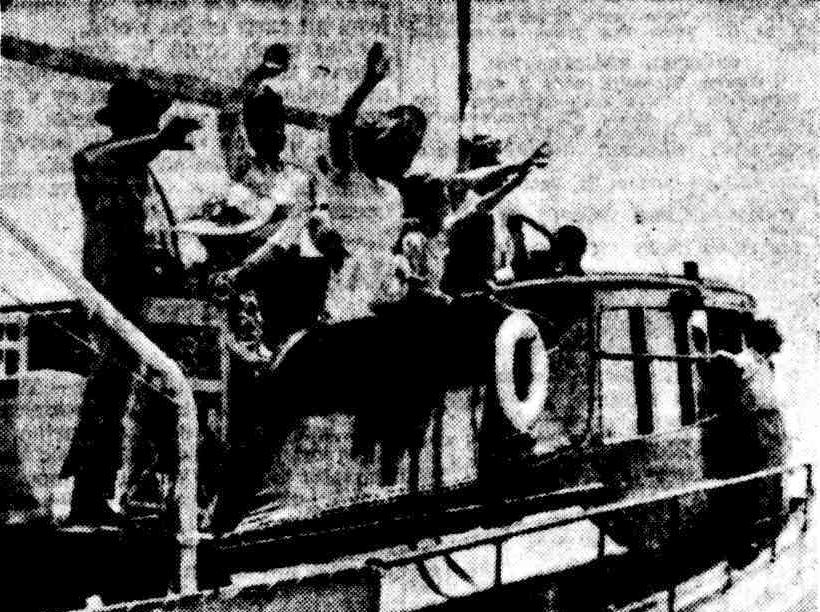
MORNA LAUNCHED . SYDNEY'S LARGEST YACHT.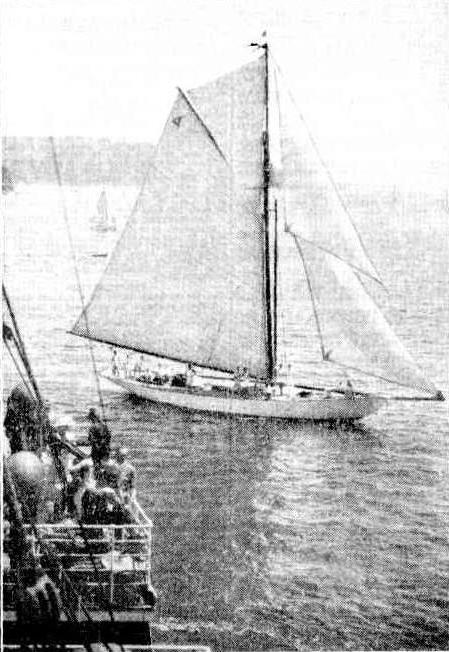 Sir Alexander MacCormick's yacht Morna, the largest vessel of her type in these waters, was successfully launched from the yards of the builders, Messrs. Morrison and Sinclair, Balmain, yesterday afternoon. As the craft ran down the ways Mrs. Adrian Knox named her the Morna, and broke a bottle of Australian wine on her bows. The guests were entertained in the saloon. The Morna, which is 65 feet long with a 13 feet beam, was designed by Mr. William Fife, of Fairlie, Scotland, to Sir Alexander's order, and the builders have produced a fine vessel.She will be used for cruising. A four-cylinder 12 horsepower Kelvin engine has been Installed, which should develop about five knots an hour. The propeller is collapsible. The interior of the yacht is finished in Queensland maple, with bronze and silverplate fittings. The accommodation comprises a saloon, a dining saloon, and a ladies' cabin. 'There are five bunks for guests and two for the crew in a well-fitted forecastle. The hull is of teak, especially imported, with a frame work of colonial hardwood, and is copper-fastened throughout. The cockpit, which is self-emptying, has a watertight coaming around it to keep out the deckwash. In the cockpit the carburetter is kept in a watertight box, and is under the control of the helmsman. The benzine tanks are on deck, and there is no danger from fire or explosion. The mast and spars were also imported. The smaller spars are of the patent hollow type. The mast will be stepped and the rigging completed immediately, and the vessel, it is expected, will be ready for her owner within two or three weeks.The Morna has a draught of eight feet, and should displace about 30 tons. MORNA LAUNCHED. (1913, August 29). The Sydney Morning Herald (NSW : 1842 - 1954), p. 7. Retrieved from http://nla.gov.au/nla.news-article15446332
Sir Alexander MacCormick's yacht Morna, the largest vessel of her type in these waters, was successfully launched from the yards of the builders, Messrs. Morrison and Sinclair, Balmain, yesterday afternoon. As the craft ran down the ways Mrs. Adrian Knox named her the Morna, and broke a bottle of Australian wine on her bows. The guests were entertained in the saloon. The Morna, which is 65 feet long with a 13 feet beam, was designed by Mr. William Fife, of Fairlie, Scotland, to Sir Alexander's order, and the builders have produced a fine vessel.She will be used for cruising. A four-cylinder 12 horsepower Kelvin engine has been Installed, which should develop about five knots an hour. The propeller is collapsible. The interior of the yacht is finished in Queensland maple, with bronze and silverplate fittings. The accommodation comprises a saloon, a dining saloon, and a ladies' cabin. 'There are five bunks for guests and two for the crew in a well-fitted forecastle. The hull is of teak, especially imported, with a frame work of colonial hardwood, and is copper-fastened throughout. The cockpit, which is self-emptying, has a watertight coaming around it to keep out the deckwash. In the cockpit the carburetter is kept in a watertight box, and is under the control of the helmsman. The benzine tanks are on deck, and there is no danger from fire or explosion. The mast and spars were also imported. The smaller spars are of the patent hollow type. The mast will be stepped and the rigging completed immediately, and the vessel, it is expected, will be ready for her owner within two or three weeks.The Morna has a draught of eight feet, and should displace about 30 tons. MORNA LAUNCHED. (1913, August 29). The Sydney Morning Herald (NSW : 1842 - 1954), p. 7. Retrieved from http://nla.gov.au/nla.news-article15446332
Right Picture: WINNER AT PITTWATER REGATTA. Morna (R. C. Packer) winner of the John Roche handicap,passing the flagship after the race.WINNER AT PITTWATER REGATTA. (1934, January 1). The Sydney Morning Herald (NSW : 1842 - 1954), p. 10. Retrieved from http://nla.gov.au/nla.news-article17036791
Sailing was MacCormick's great pleasure. He bought the yacht, Thelma, and successfully raced her in the 1890s. Joining the Royal Sydney Yacht Squadron in 1893, he was commodore in 1897-1900 and in 1913-20. In 1913 he had built a cutter, Morna, for cruising. He was a founder and first commodore of the Prince Edward Yacht Club in 1920. In 1927 he visited Scotland to supervise the building of aschooner, Ada. With four others he sailed her through the Panama Canal reaching Sydney after a four-month voyage. He was made a member of the Royal Yacht Squadron at Cowes and became the only yachtsman on Sydney Harbour privileged to fly the white ensign.
Douglas Miller, 'MacCormick, Sir Alexander (1856–1947)', Australian Dictionary of Biography, National Centre of Biography, Australian National University, http://adb.anu.edu.au/biography/maccormick-sir-alexander-7322/text12703
JUST AFTER THE START OF THE R.P.A.Y.C. RACE ON SATURDAY FOR THE BASIN CUP.
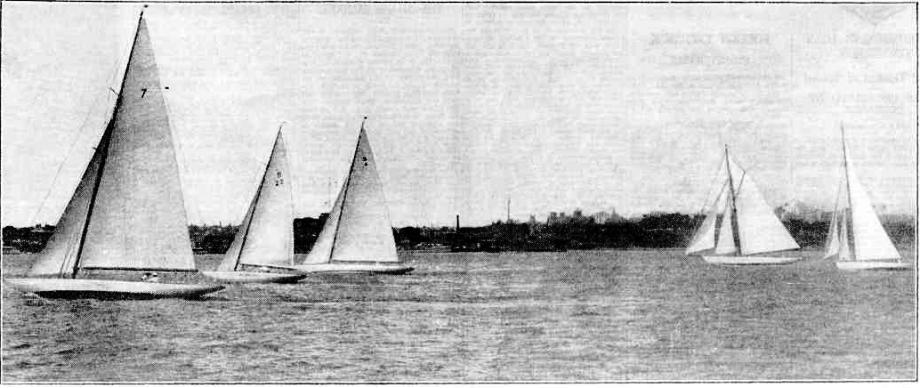
Morna (R. C. Packer), the winner, is second from the right. Utiekah II. (H. Nossiter), which came second, is on the extreme right. The third boat, Norn (A. F. Albert), is on the extreme left. The Victorian visitors, Toogooloowoo II. (B22) and Vanessa (R4), were fifth and fourth respectively. JUST AFTER THE START OF THE R.P.A.Y.C. RACE ON SATURDAY FOR THE BASIN CUP. (1932, January 18). The Sydney Morning Herald (NSW : 1842 - 1954), , p. 12. Retrieved from http://nla.gov.au/nla.news-article1683448
Morna became Mr F Packer’s for a while before being owned by Sir Claude Plowman in 1950’s.
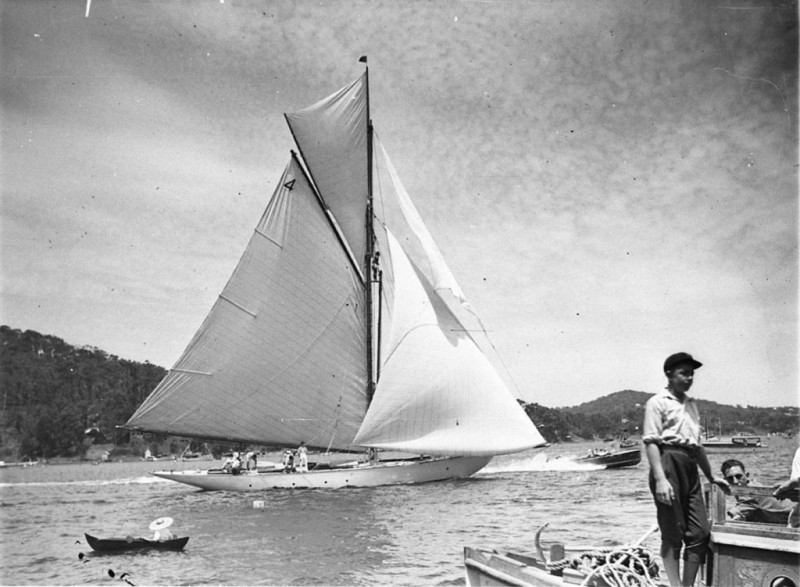
Yacht "Morna" rounding the buoy. Crewman up on halyard at Pittwater Regatta. Photo by Sam Hood, Jan 1st, 1934. Courtesy State Library of NSW.
SHOCKING AND FATAL ACCIDENT - Death of Mr. William Langford.
About a quarter past 8 o'clock yesterday morning Mr William Langford, the well-known yacht-builder, of Northshore, met his death in a manner as unexpected as it was painful. It seems that he was accustomed to have the crooks used in boats cut at Billyard's Bonemills, at Pyrmont, and went to that establishment to superintend the cutting. The man who was assisting him, Robert Berry, had got through one of the crooks as far as the bend, and, there being some difficulty in raising it so as to cut the other part, Mr Langford jumped on to the bench to ease the timber for Berry. He placed his right foot too near the circular saw, which in an instant cut through his boot took of his heel, and dragged him onto the saw. As he fell the saw passed through his right leg severed it just above the knee, and threw it a considerable distance to the lower end of the bench. In his further descent Mr. Langford's left arm came in contact with the saw, and a large strip of flesh was cut off down to the bone. As soon as possible he was taken to the Infirmary, but he died before he reached that institution.
To write of William Langford is to recall many pleasant memories in Australian aquatic history. His name has been connected with the yacht and boat building of Port Jackson for very many years, and his many well-fashioned models have won on countless occasions. It may be safely asserted that there was not a builder who better understood his business, or was more widely respected in the trade than the subject of this notice. Those to whom he was personally known need not to be reminded of his many good qualities. He was a native of Sydney. He was born in the year 1832, and was therefore 48 years of age. A widow and large family mourn his untimely end. The age of the eldest of the children is 18 years. Langford, early in life, took up his abode at Miller's Point, and it will be seen further on that his long and successful career forms in itself an extensive chapter in aquatic history. William Langford's boating premises are situated on the western side of Blue's Point, North Shore, looking on to Berry's Bay. He gained much of his building knowledge while following the trade of shipwright in his youth. For the last 27 years he has been engaged in yacht and other boat building.
Up to four years ago he was in partnership with his brother Thomas, at Miller's Point, who has since died. William devoted his attention almost entirely to the deep-keeled yachting branch of the trade. Those whose memory carry them back to the early days of yachting in Port Jackson will remember the Sea Belle, Fawn, Daisy, Dora, Lubra, and Calypso, which were built under the supervision of William Langford. Later on, when deep keel boats became fashionable, that little wonder, the Nereid, was built for Messrs. Fairfax and Lassetter. Since that period the number and names of vessels that Langford has built are very numerous. He has built about sixteen vessels for the pearl shell fisheries in Torres Straits. Among them was the schooner Two Brothers, and the centreboard yacht Maude, for Queensland.
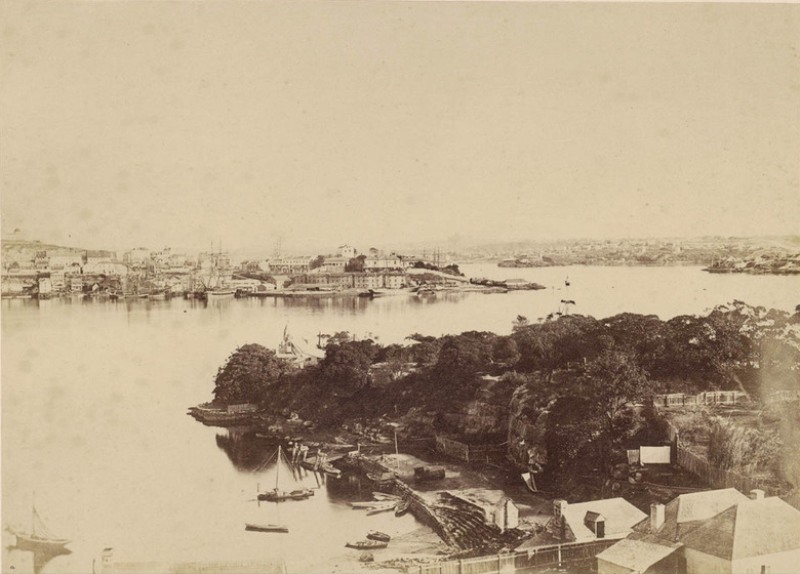
"Millers Point" from North Shore, undated [1870s ?], Image No.: a089933, courtesy State Library of NSW.
Latterly he constructed the steam watertank Gleaner, for Mr. Fenwick, and the framework of an unfinished steam launch occupies his building shed. All the pearl shell boats he turned out gave great satisfaction, both for speed and weatherly qualities. It was, however, in the yachting line that Langford excelled as a builder, and it is not going too far to say that he died a man who has done more than any other in his vocation to render Port Jackson famous as the leading yachting centre of the Southern Seas. After the Nereid, he framed the Ione, which had a wonderful career of success, under the ownership of Mr J. F. Jackson. Then followed the little Orpheus; and next in turn came Langford's great chef d'ouvre the Magic, 28 tons to the order of Mr Alfred Fairfax. The Magic's brilliant achievements on the water are too numerous to be dealt with in a notice of this kind, and she is apparently destined to long survive her builder in her career of success, under the colours of Mr James R. Fairfax. The next yacht launched was the Pleiades, 10 tons for Messrs. T. and W. Knox, and her fame as a racer shows out brilliantly in yachting history. The Meteor followed in the wake of the Pleiades, a craft of about the same measurement, but fuller lines She was built for Mr S. Hordern and is at present owned by Mr. James R. Fairfax. These yachts were all designed by Langford, and they have proved not only very fast, but remarkably durable.
Langford's next task was to construct a 10-ton yacht for Mr. J. F. Jackson, and designed by the late Dan Hatcher, who is reputed to have turned out the best yachts in England of the 10-tons and under class. The Violet, as the new boat was called, defeated everything of her size that she ran against, and gave us the first practical demonstration of the advantage of carrying the ballast on the keel. In Langford's next model, the Mabel, now owned by Mr. Love, he took a leaf out of the English builders' book, and clapped two and a half tons of metal on the keel. Mabel has been a lucky prize winner, and her owner may justly be proud of her. Mr J. H. Want, Commodore of the Prince Alfred Yacht Club, then favoured Langford with an order for the fastest 10-tonner he could build, but in this vessel Langford discarded the lead keel, believing that by placing the ballast well down on the inside of the yacht it would prove as effective. The Guinivere, however, did not come up to expectations, so the builder took her in hand again last year, removed a lot of the dead wood from her heel, and rounded off her stem The alterations had the desired effect, and Mr Want possesses in the Guinivere one of the fastest yachts in our waters. The Oithona,15 tons, on lines by a Scotch architect, for Dr. Mackellar, was the last beautiful piece of yachting work from this builder's yards. It may be said of William Langford in brief, that he attained the highest reputation as a yacht-builder, he has left a good name behind at the end of a life steadily devoted to business, and passed to the grave amid the regret of a large part of the community, especially of those who take an interest in aquatics. SHOCKING AND FATAL ACCIDENT. (1881, February 19). The Sydney Morning Herald (NSW : 1842 - 1954), p. 3. Retrieved from http://nla.gov.au/nla.news-article13479341
The Late Mr. William Langford.
On the morning of Friday, 18th instant, Mr. William Langford, the well-known yacht-builder, of North Shore, met his death in a manner as unexpected as it was painful- It seems that he was accustomed to have the crooks used in boats cut at Billyard's Bonemills, at Pyrmont, and went to that establishment to superintend the cutting. The man who was assisting him, Robert Berry, had got through one of the crooks as far as the bend ; and, there being some difficulty in raising it so as to cut the other part, Mr. Langford jumped on to the bench to ease the timber for Berry. He placed his right foot top near the circular saw, which in an instant cut through his boot, took off his heel, and dragged him on to the saw. As he fell, the saw passed through his right leg, severed it just above the knee, and threw it a consider-able distance to the lower end of the bench. In his further descent Mr. Langford's left arm came in contact with the saw, and a large strip of flesh was cut off down to the bone. As soon as possible he was taken to the In-firniary, but he died before he reached that institution.
To write of William Langford is to recall many pleasant memories in Australian aquatic history. His name has been connected with the yacht and boat building of Port Jackson for very many years, and his many well-fashioned models have won on countless occasions. It may be safely asserted that there was not a builder who better understood his business, or was more widely respected in the trade than the subject of this notice. Those to whom he was personally known need not to be reminded of his many good qualities. He was a native of Sydney. He was born in the year 1832, and was therefore 48 years of age. A widow and large family mourn his untimely end. The age of the eldest of the children is 18 years. Langford, early in life, look up his abode at Miller's Point, and it will be seen further on that his long and successful career forms in itself an extensive chapter in aquatic history. William Langford's boating premises are situated on the western side of Blue's Point, North Shore, looking on to Berry's Bay. He gained much of his building knowledge while following the trade of shipwright in his youth. For the last 27 years he has teen engaged in yacht and other boat building. Up to four years ago he was in partnership with his brother Thomas, at Miller's Point, who has since died. William devoted his attention almost en-tirely to the deep-keeled yachting branch of the trade. Those whose memory carry them back to the early days of yachting in Port Jackson will remember the Sea Belle, Fawn, Daisy, Dora, Lubra, and Calypso, which were built under the supervision of William Lang-ford. Later on, when deep-keel boats became fashionable, that little wonder, the Nereid, was built for Messrs. Fairfax and Lassetter. Since that period the number and names of vessels that Langford has built arc very numerous. He lias built about sixteen vessels for the pearlshell fisheries in Torres Straits. Among them was the schooner Two Brothers, and the centreboard yacht Maude, for Queens-land. Latterly he constructed the steam watertank Gleaner, for Mr. Fenwick, and the framework of an unfinished steam launch occupies his building shed. All the pearlshell boats he turned out gave great satisfaction, both for speed and weatherly qualities.
It was, however, in the yachting line that Langford excelled as a builder, and it is not going too far to say that he died a man who has done more than any other in his vocation to render Port Jackson famous as the leading yachting centre of the Southern Seas. After the Nereid, he framed the lone, which was built to the order of Mr. J. Graffon Ross, and achieved her first success under his ownership, and afterwards proved a first-class five-tonner; she was purchased by Mr. J. F. Jackson, and is now the property of Mr. A. Milsom. Then followed the little Orpheus ; and next in turn came Langford's great chef d'auvre the Magic, 28 tons, to the order of Mr. Alfred Fairfax. The Magic's brilliant achievements on the water are too numerous to be dealt with in a notice of this kind, and she is apparently destined to long survive her builder in her career of success, under the colours of Mr. James R. Fairfax. The next yacht launched was the Pleiades, 10 tons, for Messrs. T. and W. Knox, and her- fame as a racer shows out brilliantly in yachting history. The Meteor followed in the wake of the Pleiades, a craft of about the same measurement, but fuller lines. She was built for Mr. S. Hordern, and is at present owned by Mr. James R. Fairfax. These yachts were all designed by Langford, and they have proved not only very fast, but remarkably durable. Langford's next task was to construct a 10-ton yacht for Mr. J. F. Jackson, and designed by the lato Dan. Hatcher, who is reputed to have turned out the bost yachts in England of the 10-tons and under class. The Violet, as the new boat was called, defeated everything of her size that she ran against, and gave us the first practical demonstration of the advantage of carrying the ballast on the keel. In Langford's next model, the Mabel, now owned by Mr. Love, he took a leaf out of the English builders' book, and clapped two and a half tons of metal on the keel. Mabel has been a lucky prize winner, and her owner may justly be proud of her. Mr. J. H. Want, Commodore of the Prince Alfred Yacht Club, then favoured Langford with an order for the fastest 10-tonner he could build; but in this vessel Langford discarded the lead keel, believing that by placing the ballast well down on the inside of the yacht it would prove as effective. The Guinevere, however, did not come up to expectations, so the builder took her in hand again last year, removed a lot of the dead wood from her heel, and rounded off her stem. The alterations had the desired effect, and Mr. Want possesses in the Guinevere one of the fastest yachts in our waters. The Oithona, 15 tons, on lines by a Scotch architect, for Dr. Mackellar, was the last beautiful piece of yachting work from this builder's yards. It may be said of William Langford, in brief, that he attained the highest reputation as a yacht-builder; he has left a good name behind at the end of a life steadily devoted to business, and passed to the grave amid the regret of a large part of the community, especially of those who take an interest in aquatics.
At the luncheon tendered on Saturday last by the Royal Yacht Squadron to their Commodore, Mr. W. O. Gilchrist, Mr. H . O. Dangar said he was compelled to refer in terms of deep regret to the loss they had sustained in the death of William Langford. (Applause.) He possessed in a remarkable degree the knowledge of that mysterious secret of producing speed in connection with form in yacht-building. (Applause.) He never turned out a bad yacht ; he often built very good ones, and he always put into them faithful work. Let them look at the beautiful lines of the Magic, and at the graceful Guinevere — one of the best second-class yachts in Australia. Indeed, there were few yachts of any kind to equal her ; and only that day he had directed a friend's attention to her many beauties. But, apart from his admiration of Langford as a yacht designer, he could not but record his admiration of him as a thoroughly honest man, whose work never needed watching. (Applause.) He ever consulted the interests of his employer rather than his own ; and if it should happen that his family, those he left behind him, required that help which widows often required, he hoped the yachtsmen of Sydney would remember that they had made it one of their rules to render help to vessels in distress, weaker vessels, and he could only say that he should be one to do so. (Applause.)
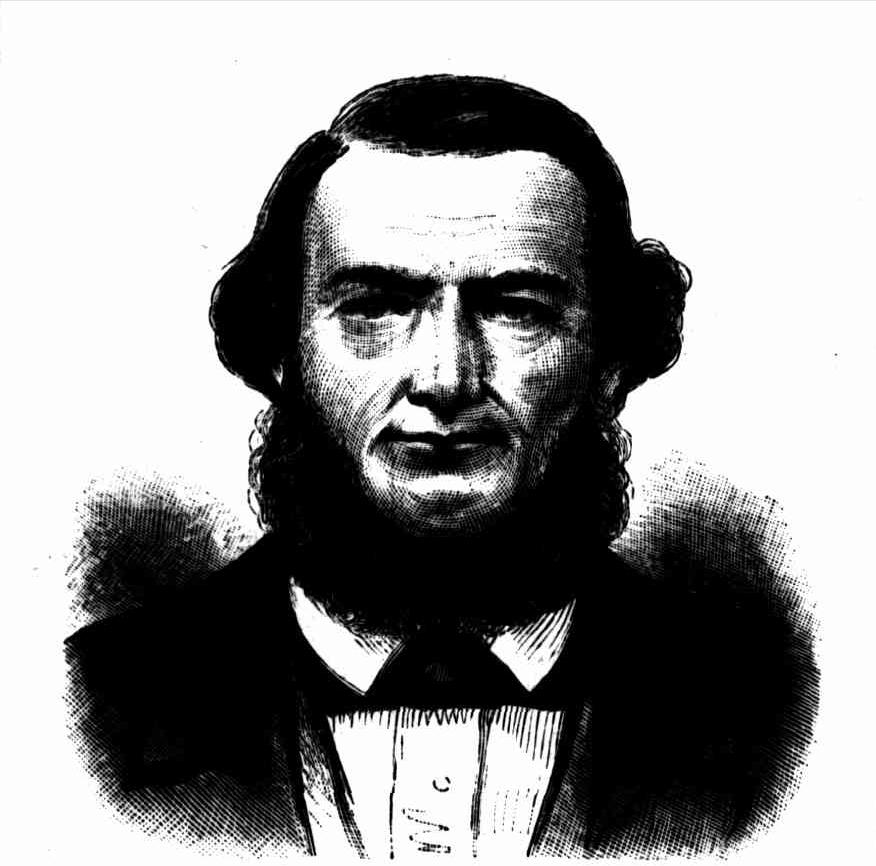
THE LATE MR. WILLIAM LANGFORD, Yacht-Builder.
The Late Mr. William Langford. (1881, February 26). The Sydney Mail and New South Wales Advertiser (NSW : 1871 - 1912), p. 332. Retrieved from http://nla.gov.au/nla.news-article161882011
FATAL ACCIDENT to- Mr. WILLIAM, LANGFORD. The public were shocked yesterday by a rumour to the effect that Mr.William Langford, the well-known yacht and boat builder, had met his death from injuries at a sawmill. The rumour proved but too true; Mr! Lang ford, who bad been building a steam launch at his shed at the North Shone, went yesterday, morning to Billyard's sawmills, Pyrmont, to have some timber cut for nor. inaa nninou uerrv was engageu in holding the wood to the saw while ilr. Langford was superintending and assisting, and was nearer the saw, leaning on the travelling bench which carries the wood a gain & t the . saw. . it seems from aoine cause or other the wood canted and caused Mr. Langford to slip, -the saw immediately catting off his heel. In his effort to disengage himself, unfortunately, he slipped against the wheel, which in an instant severed-his left leg above the knee, and terribly mangled his left arm. The whole thing occurred in an instant, and nothing could be done to save-him from the fatal collision with the saw.
Whilst Berry, who was kneeling, was looking down at the work, he felt the timber jerk up and strike him on the chest, and in his own words, "on looking up I saw poor Latreford falling, and his left leg falling upon the ground a little distance off." The injured man was at once picked up and conveyed to the Sydney Infirmary, but before arriving at the institute, life had departed. Upon examination at the Infirmary, it was found that, besides the left leg being severed, a terrible gash had been inflicted on the left arm, and a severe cut on the right foot and the poor fellow's remains altogether presented a frightfully mangled appearance.
Mr. William Langford was a native of Sydney, and was in his 48th or 49th year. He and his brother, Thomas Langford, have been famous as yacht and boat-builders, having constructed the most of the fast yachts and a great number of the smaller boats in the harbour. Their workmanship and materials were always of the best, and in this respect they have never been excelled in Sydney. Our readers will, no doubt, remember that some six months ago we chronicled the death of Mr. Thomas Langford, at his residence, Clyde-street, from consumption. The brother was very much affected by his death. The two were mere lads at the death of their father, Mr. William Langford, who had carried on the business of boatbuilder at the foot, of Clyde-street, near where Dibbs Wharf now is. This son, William, had been apprenticed as shipwright at the Patent Slip, and Thomas served an apprenticeship with the well-known boat-builder, Andrew Reynolds. At the death of their father the property was somewhat encumbered, and the two young fellows joined in partnership as boat-builders, and by dint of steady industry redeemed the property. This was about 70 years ago. From that time up to five or six years ago the partnership continued, and then Mr. William Langford, whose sad end we have to notice, removed his residence and workshop to the North Shore, in Berry's Buy, near Billy Blue's Point. The Langfords were much respected as industrious, steady, quiet men of unswerving honesty. If they had carte Uanvhc to build a boat or yacht, everyone knew she would not cost a farthing more than if the work was closely looked after, a rare virtue in these degenerate times. The yachts they built are household words among yachtsmen and in every class they still retain pre-eminence. We believe the Sea Belle was the first half-decked sailing bout they built, some 30 years ago. Then followed the Spray ...
Mr. William Langford drew the designs, but the brother's practical knowledge, of course, assisted until, the partnership was dissolved. Mr. Langford leaves a widow and a numerous family of nine, the eldest, we believe, not more than 17. The melancholy circumstances surrounding his death will necessitate a coroner's inquest being held to-day. FATAL ACCIDENT to Mr. WILLIAM LANGFORD. (1881, February 19). The Sydney Daily Telegraph (NSW : 1879 -1883), p. 5. Retrieved from http://nla.gov.au/nla.news-article238303860
OCEAN YACHT RACE.
WAITANGI-ELECTRA-SAO. VICTORY FOR THE YAWL.
A race which has been looked forward to with much Interest in sailing circles came off on Saturday afternoon. This was the race between Vice-Commodore Milson's well-known yacht Waitangi, Mr. Fitzhardinge's new yawl, Electra; and Mr. Milford's yacht Sao. The Sao was allowed a handicap of 60 minutes, the other two vessels starting scratch. The course was from a line between the starter boat and the French buoy in Neutral Bay, down to and round a boat moored off Barrenjoey, and back to Fort Macquarie. This course is about 50 miles in length. The canvas: used by the yachts was restricted to the pleasure mainsail,- balloon and working foresails, jib-headed tops and working jib, no booming out of sails with spat allowed, otherwise, R.S.Y.S. rules observed. The steamer Albatross, Captain Amora, followed the race, and only a, small party proceeded in her. Mr. W. J. Trickett was commodore of the day. The breeze being very light at 10 a.m., the start was deferred until about quarter to 11 o'clock, when the Electra was first across the line at twelve minutes to 11, followed by the Waitangi 5sec later, and then the Sao 1min 10sec from the Waitangi. The Electra held her load, and passed Bradley's in good form. The Waitangi got into calm under ' Bradley's, while tho Sao was in a southerly course. The Waitangi carried away her topsail 'block and this delayed her some time. The breeze freshened after passing Bradley's, and going across to Rose Bay the Waitangi gained somewhat. At Shark Point: the yachts went about and stood over for Chowder thence tacking across for tho eastern shore. The Electa got a good increase in her lead, leaving the Bottle and Glass, and stood well away out under South Head. The Electra stood well out with a long lead, and the Sao went out for a mile and then went about for a beat to the northward, going on as far as Honeycomb Rock then went about and stood out again. East of the rock another tack had to be made, and she stood well out again, Electra tacked and made a board off Bluefish,' the Sao to windward, and a good race between them. Passing Curl Curl the Electra, stood well out to sea, and made about to clear Long Reef. Here the Waitangi had a good lead from the Sao. Off Narrabeen the Waitangi led the Sao by a quarter, of a mile, the Electra a mile ahead of the Waitangi. Off the mouth of Narrabeen Lagoon the Waitangi, with a long lead, and the Sao went about. By this time the Electra had a full half hour's lead, and was evidently, the winning boat, bar accident. The Electra’s time on passing the flagboat at Barranjoey was 3h 85min, having fully half an hour's lead of the Waitangi. Coming back to the Heads, the Electra passed through at twenty minutes to 6, and passed the flagboat off Port Macquarie at 6h 9min 30sec. The Waitangi passed at 6h 40min 80seo,the Sao at 7h 19min. The time for tho whole course sailed by the Electra was 7h 21min 81sec, The prize was a handicap of £10 each. Notwithstanding that the weather was beautifully fine, some of the passengers wore shockingly affected by mal de mer, and were quite unable to enjoy tho beauties of the trip. Somehow or other people here have not tho opportunity to overcome this dreadful suffering, owing to the few opportunities offered them for a short trip to sea. There will be other opportunities before the close of the season. OCEAN YACHT RACE. (1886, April 3). Australian Town and Country Journal (NSW : 1870 - 1907), p. 40. Retrieved from http://nla.gov.au/nla.news-article71075535
A CHARMING DRIVE. MANLY TO BARRENJOEY.
BY BUSH AND SEA.
There are so many charming walks and drives around Sydney that it is almost impossible to say one exceeds the other in its attracttions. But among the many there are few people who will dispute the claims of the country lying between Manly and Barrenjoey. A portion of this very picturesque neighborhood has recently been brought nearer the pleasure-seeking people by the tram extension to Collaroy Beach, which is within striking distance of Narrabeen. The running of a regular tram service to this point must help to popularise the district, and it is already in evidence that many more people visit this magnificent stretch of beach than was the case when only coaches provided the means of transit.
The road from Manly northwards along the coast through Narrabeen, Rocklily, to Bayview, and Church Point, on the one hand, and to Newport and Barrenjoey on the other, is not so well known to the masses as it should be, al-though its charms are more widely enjoyed since the advent of the motor car.
After leaving Manly, the tram at a distance of about three miles passes through Brook-vale along a pretty road, by sea and bush. It is an attractive little village, in fine surroundings, and in the distance may be discerned Beacon Hill, on the French's Forest-road, whence an extensive panoramic view is to be obtained. A mile and a half further on are the Oxford Falls, which find an outlet in the Narrabeen lakes.
But the route proper is the Pittwater-road, and as we pass along we see the fine buildings erected and controlled by the Salvation Army, and that quiet stretch of placid water known as Deewhy Lagoon, whose surface is often covered with black swans. Within seven miles of Manly is Narrabeen itself, whose lagoon winds for miles into French's Forest. This lagoon, however, is very shallow, and is not navigable with safety for any distance except to shallow draught boats which are available on the banks near the main road. On the ocean side is a fine beach considered safe for surf-bathers, but those who fear to venture into the open sea may fall back on the still waters of the lagoon. A number of fishermen are located here, and large quantities of fish are annually netted in the lagoon.
Two miles further on we reach Rocklily, which boasts an hotel, recreation grounds, and a park, the entrance being guarded by a can-non which has done service in its day. Within the hotel itself is a fine collection of paintings, the work of a late proprietor. After passing through Mona Vale — a picturesque settlement possessing several fine buildings, including elaborate club rooms and cottages — a branch of the road is passed which leads to Gordon and Pymble on the Milson's Point-Hornsby railway, and later the excursionist must choose his road, as one will take him to Bay View and Church Point, while the other will land him at Newport. The main road, however, continues to Newport and Barrenjoey Lighthouse.
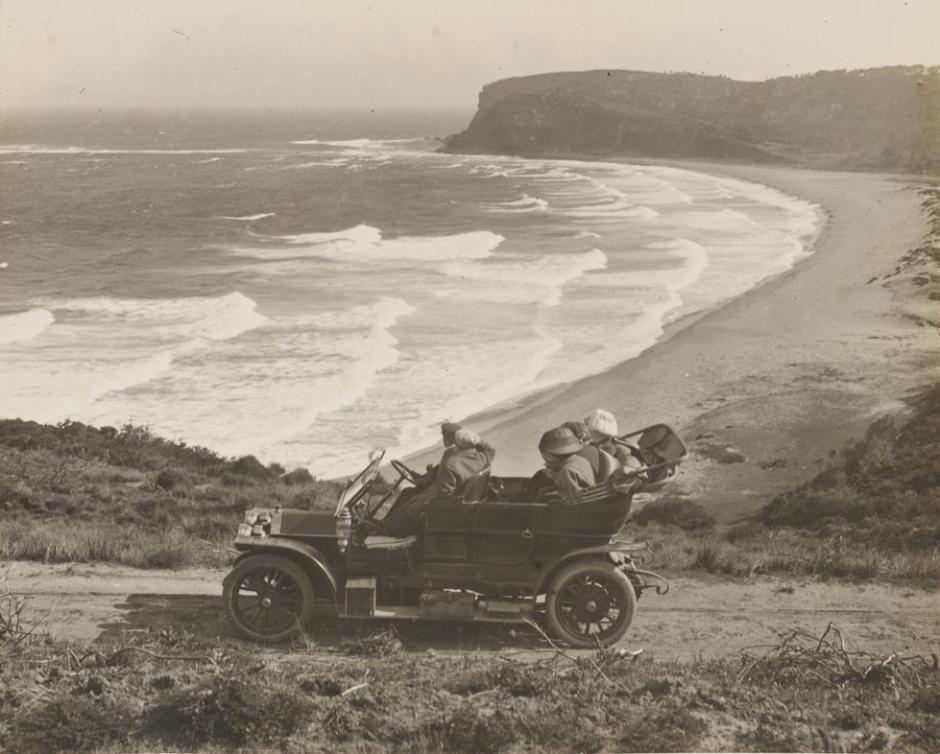
'The Beach just beyond Newport' - November 21st, 1909 - from Allen Family Albums: Album 52: Photographs of the Allen family, November - December, 1909 Image No.: a1373015h courtesy State Library of NSW
Bay View, eleven miles from Manly, and Church Point, three miles further on, are well worth a visit. From the head of the bay there is an extensive and beautiful view over the expanse of Pittwater, with Scotland Island in the mid-distance, and the hills of Kuring-gai Chase in the far distance. The roadway skirts the water to Church Point, whence the journey may be made to Newport to launch if so desired. From Church Point a view is obtained of some seven miles of water of Broken Bay and Barrenjoey, with Lion Island standing like a grim sentinel in the path. It is an ideal position for a quiet and picturesque home. Newport — 12 miles from Manly — is also a most charming retreat, and possesses two good hotels. A short walk to the point where the road branches off to Barrenjoey, gives visitors a magnificent view, and within easy distance is Bushranger's Hill, which recalls a time when these lawbreakers, from which the elevated site takes its name, made their attacks upon the unsuspecting mailman. There is a fine sandy, ocean beach within a few minutes walk of the hotel, where surf-bathing is indulged in. Close by is the road leading to Barrenjoey Lighthouse, which occupies a picturesque and prominent position at the entrance to Bro-ken Bay, and so well-known to yachtsmen. All these places may be reached by coaches which meet the trams at Narrabeen, and it is safe to say that, once the beauties of the drive are known, and greater facilities provided for reaching them, this glorious coastline will be the most popular out of Sydney. A CHARMING DRIVE. (1912, December 19). Evening News (Sydney, NSW : 1869 - 1931), p. 12. Retrieved from http://nla.gov.au/nla.news-article113777520
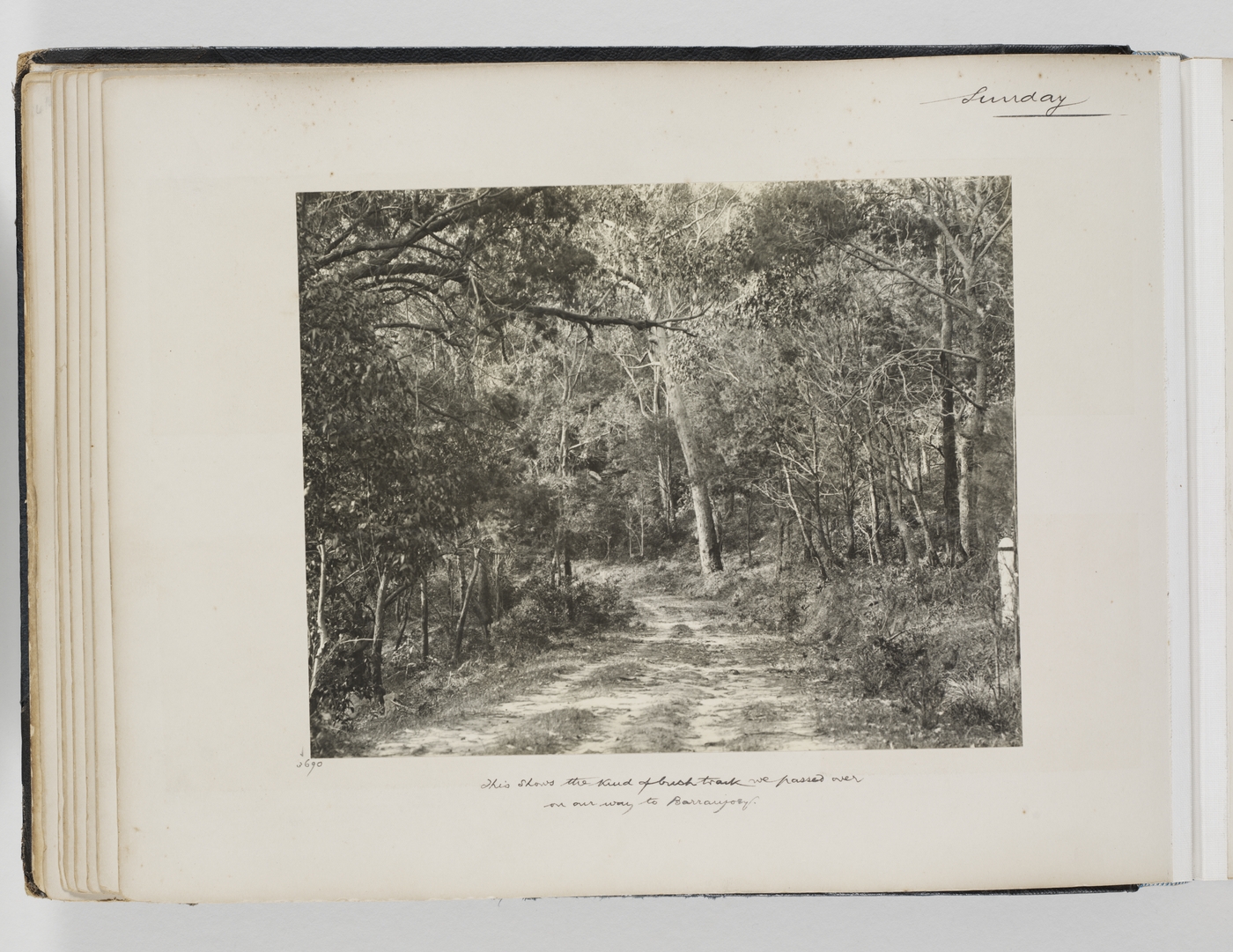
Album 52: Photographs of the Allen family, November 1909 - Digital Order Number: a1373018 courtesy Mitchell Library, State Library of New South Wales.
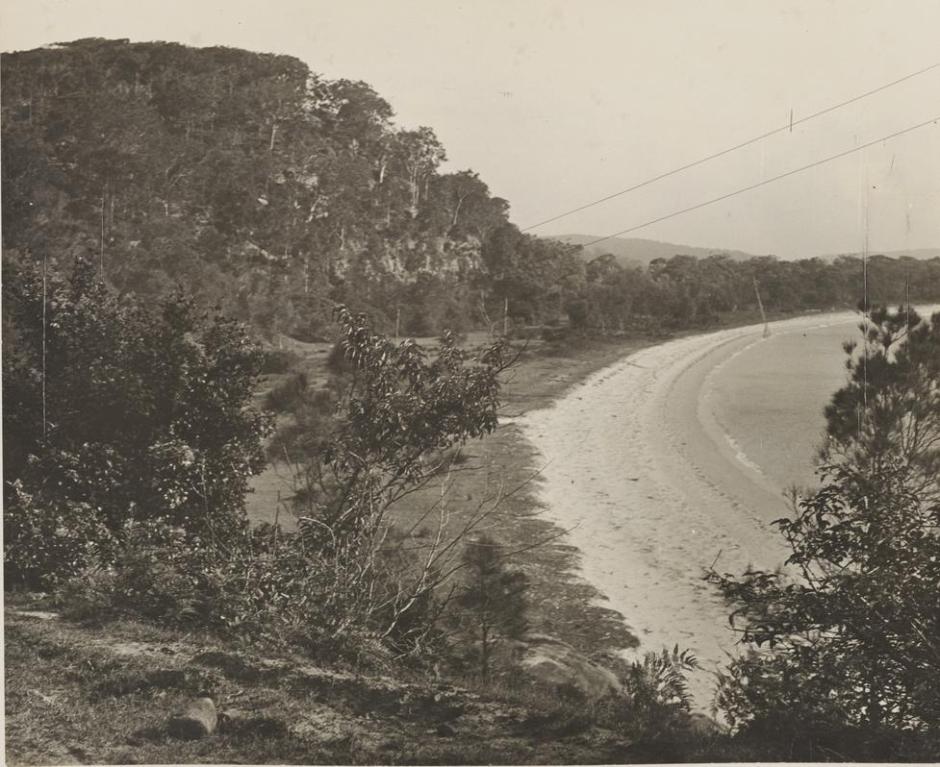
Snapperman Beach, Pittwater, prior to being named so - from Allen Family Albums - "Sunday 21st of November 1909" Images No.: a1373021h and below: a1373020h , "Climbing last hill before reaching Barrenjoey: both courtesy State Library of NSW
